
Queensland Reconstruction Authority
June 2022
The social, financial and
economic costs of the 2022
South East Queensland Rainfall
and Flooding Event
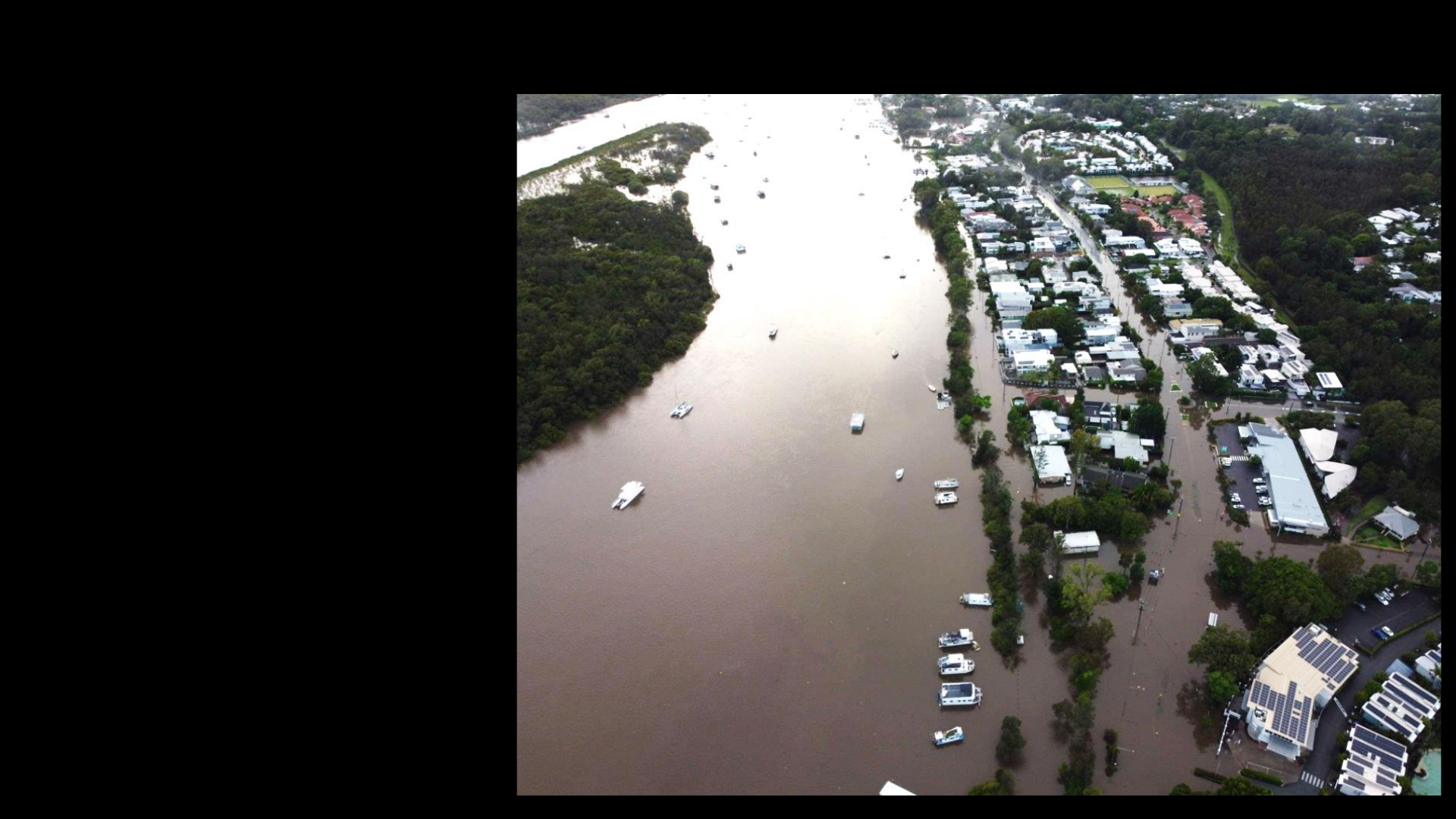
22
The social and economic costs of the 2022 South East Queensland Rainfall and Flooding Event
Contents
Noosa River.
Source: HLW 2022 Flood Impact Map
Executive Summary.
Background.
Overview of Approach.
Social, Financial and Economic Costs.
Regional Impacts.
Technical Appendix.
01
02
03
04
05
06
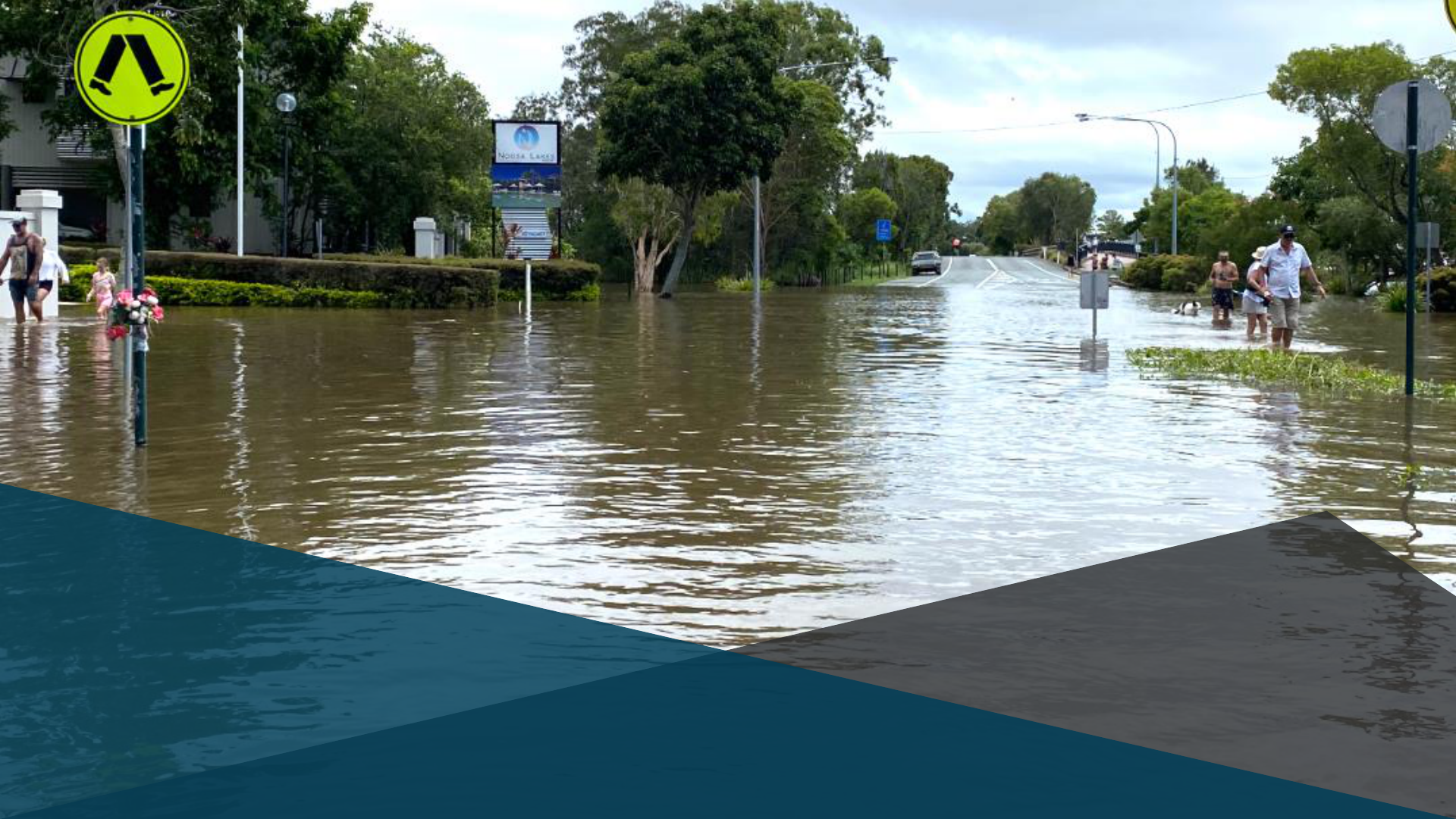
Executive
Summary
Noosa Lakes Resort 26 February 2022.
Source: HLW 2022 Flood Impact Map

4
© 2022 Deloitte Access Economics. Deloitte Touche Tohmatsu
26%
7%
4%
3%
1%
1%
58%
Residential and commercial damage Public infrastructure damage
Lost economic activity Agricultural production lost
Emergency response costs Fatalities and injuries
Health, social and community impacts
The 2022 South East Queensland (SEQ) Rainfall and Flooding event (the Event) had significant and
far reaching social, financial and economic costs on the affected population. Overall, these floods
caused a total cost of $7.7 billion to Queensland, taking account both historical tangible costs
and the NPV of lifelong health and social costs. These costs have been estimated based on data
collected between March and May 2022.
The largest component of this was the intangible health and social costs associated with the event,
with a total of $4.5 billion. The tangible, economic costs amounted to approximately $3.1 billion.
Residential and commercial damage represents the largest tangible financial cost of the 2022
SEQ rainfall and flooding event. Damage to property, contents and motor vehicles were significant,
costing approximately $2 billion. Notably, this figure is made up of estimates for both insured and
uninsured losses.
Public infrastructure damage is another significant cost to SEQ, with extensive road and public
infrastructure damage across the affected Local Government Areas (LGA). Overall, damage to public
infrastructure has been estimated to be $492 million.
Lost economic activity was significant across the affected areas as the floods and rainfall caused
physical damage to businesses, as well as disrupted business operations due to road and public
transport closures. This has been estimated to have cost small businesses a total of $324 million.
Agricultural production lost has been estimated to have cost affected LGAs approximately $254
million.
Emergency response and clean-up costs covered the costs of a range of operations and support
run by the Queensland Reconstruction Authority (QRA), other government agencies and not-for-
profit organisations. This included clean-up costs, temporary housing costs and emergency grants
for affected households, costing approximately $65 million in total.
Fatalities and injuries were estimated and monetised, resulting in an overall cost of $84 million to
affected persons and communities.
Health, social and community impacts were significant given the far-reaching and traumatic
nature of this event. As such, the toll that the SEQ floods will have on mental health, disease and
social issues are estimated to be long-lasting, and cost approximately $4.4 billion.
Key findings.
Figure 1: Cost breakdown for the 2022 SEQ Rainfall and Flooding event
The 2022 SEQ Rainfall and Flooding event
is estimated to have cost $7.7 billion in
social, financial and economic impacts.
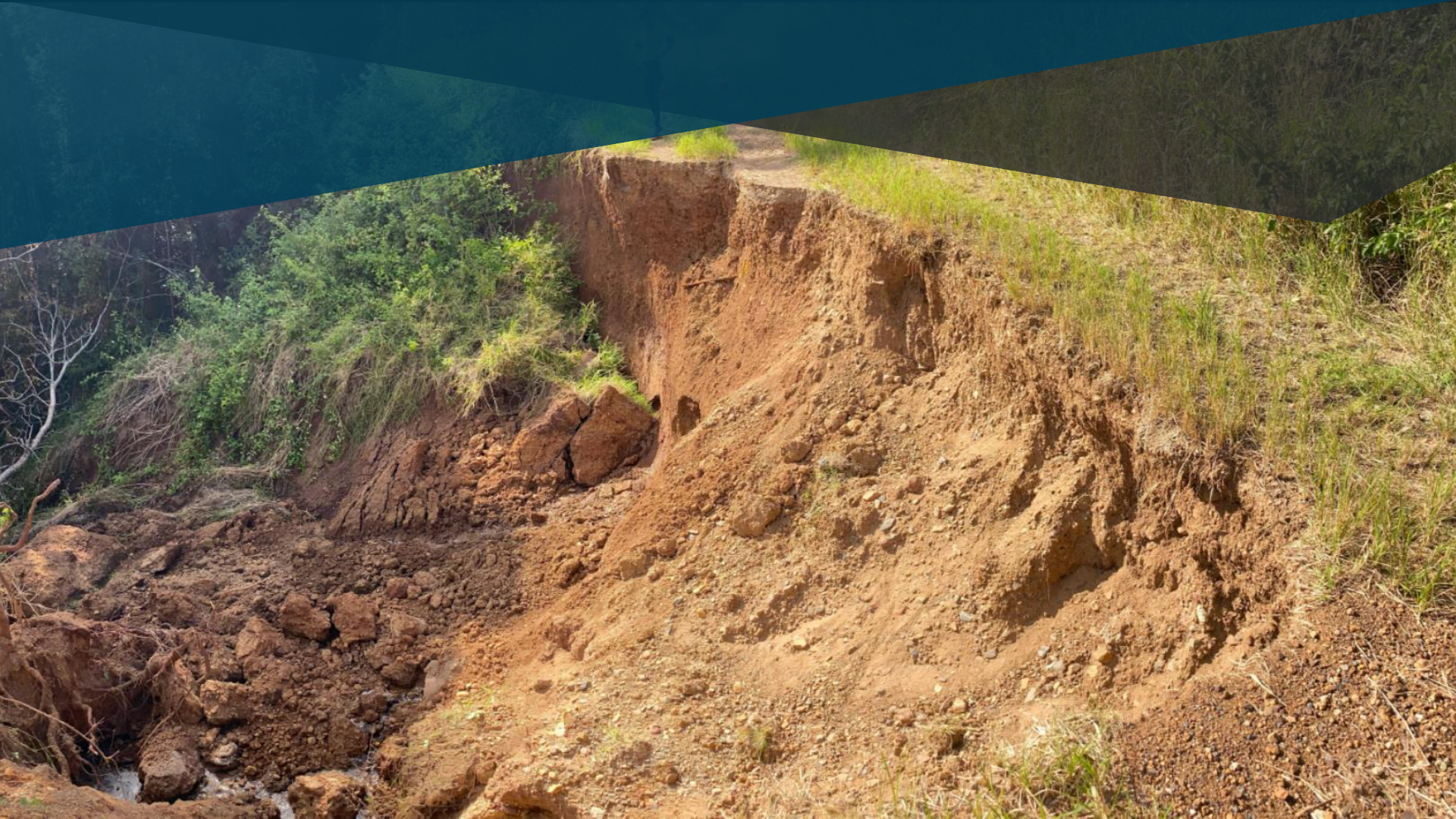
Background.
Gully erosion on access track to Ipswich Council
Reserve. Land slip on access track
Source: HLW 2022 Flood Impact Map

6
© 2022 Deloitte Access Economics. Deloitte Touche Tohmatsu
This analysis.
The 2022 SEQ Rainfall and Flooding event (“the event”) had – and continues to have – wide-
ranging impacts on individuals, businesses, communities and the economy. The impacts of the
event are still being assessed, and compounded by successive weather events.
The purpose of this report is to estimate the social, financial and economics impacts of the
flood using information collected to-date by QRA, in conjunction with other Queensland
Government agencies.
The report will be used to understand the magnitude and type of social, financial and economic
costs associated with the 2022 SEQ Rainfall and Flooding event. This is important for aligning
the identified impacts to the appropriate lines of functional recovery, which will serve as a tool
for evaluating existing disaster recovery planning and operations, as well as inform future
disaster recovery and resilience policy planning (The State Recovery and Resilience Plan).
The impacts presented in this report are the social, financial and economic costs of the event
and do not reflect the total impact the event had on Gross State Product.
The report presents:
• CHAPTER 1 | Background: Provides an overview of event details and the compounding
impacts of natural disasters.
• CHAPTER 2 | Overview of Approach: Summarises the scope of analysis and the approach
adopted in monetising the social and economic impact of the event.
• CHAPTER 3 | Social, Financial and Economic Costs: Presents the social, financial and
economic costs of the event, broken down by damage category.
• CHAPTER 4 | Regional Impacts: Discusses how the scope and scale of impacts varies by
region, with case studies for Gympie, Lockyer Valley and Ipswich presented.
• Appendix | Technical Appendix: Sets out the technical methodology, key assumptions,
data sources and sensitivity analysis.
Figure 2: QRA Disaster Funding Activations Map, 2022 SEQ Rainfall and Flooding
Source: QRA Disaster Funding Activations Map, 2022 SEQ Rainfall and Flooding.
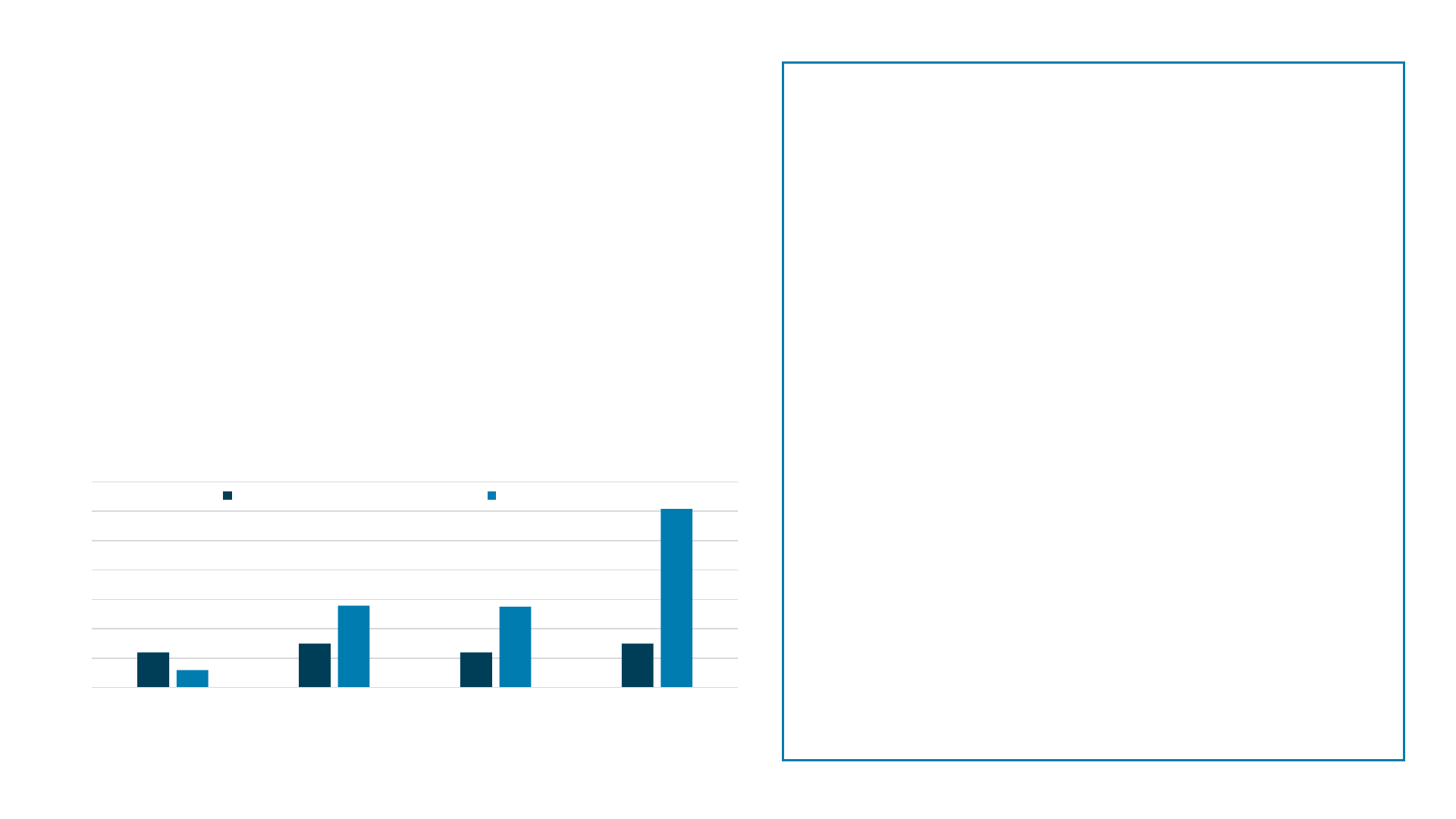
7
© 2022 Deloitte Access Economics. Deloitte Touche Tohmatsu
Event details.
From 22 February to 5 April 2022, South East Queensland (SEQ) experienced unprecedented heavy
rainfalls and major flooding. The rainfall levels experienced in Brisbane significantly exceeded the
Bureau of Meteorology’s (BOM) forecasted maximum between 25 – 27 February. Due to the rapid
escalation of the event, there was limited time to prepare. As a comparison, in the 2010-11 SEQ
flooding event, before the river rose, Brisbane City Council had three days' notice to prepare and to
assist residents to prepare for the event.
1
23 LGAs were activated under the joint Commonwealth-State Disaster Recovery Funding Arrangements
(DRFA) in the South East Queensland Rainfall and Flooding event. 21 of these LGAS were also activated
for measures under DRFAs for other events within the 2021 – 2022 disaster season, with South and
North Burnett, Gympie and Bundaberg LGAs being active under four events.
2
These disasters have had
direct and indirect economic and social impacts on individuals, communities and businesses, with
impacts compounding for those regions that were hit with a new disaster during recovery. Both the up-
front costs and the longer term community impacts will depend in part on the resilience of the
community to withstand, respond to and recover from disaster events.
Timeline of event
3
Thursday 24 February 2022
• Early warning alerts – severe
weather warning and creek flooding
Friday 25 February 2022
• Rainfall: 216mm (day average),
Brisbane City
• Queensland Government requests
drivers asked to avoid all non-
essential travel
Saturday 26 February 2022
• Rainfall: 195mm (average). Brisbane
River Flood/Tide Peak: 1.81m (AM)
1.87m (PM)
Sunday 27 February 2022
• Rainfall: 350mm (average). Brisbane
River Flood/Tide Peak: 3.01m (AM)
3.41m (PM)
• QLD Premier declares disaster in
Brisbane - urges SEQ residents to
stay home.
Monday 28 February 2022
• Rainfall: 9mm (average). Brisbane
River Flood/Tide Peak: 3.85m (AM)
3.41m (PM)
• State and non-state SEQ schools
were closed across 13 LGAs
Tuesday 29 February 2022
• Rainfall: 1mm (average). Brisbane
River Flood/Tide Peak: 3.85m (AM)
3.41m (PM)
• Morning high tide restricted clean-up
efforts and movement in some areas
0
100
200
300
400
500
600
700
Thursday 24th Friday 25th Saturday 26th Sunday 27th
Maximum forecasted Actual Maximum
Source: BOM. Forecasted rainfall as against the actual average and actual maximum rainfall for Brisbane City
1
Brisbane City Council (2022). Brisbane Flood Review
2
QRA (2022).
3
Brisbane City Council (2022). Brisbane Flood Review.
Chart 1: BOM forecasted and actual rainfall for Brisbane
Wednesday 30 February
• Day 1 of Recovery and Kerbside
collection
• Mud Army 2.0 registrations open
Thursday 3 March 2022
• QLD Premier makes media
announcement for people to
consider staying at home for the
next 24‐48 hours due to unstable
weather conditions.
• Initial roll‐out of 100 Mud Army 2.0
volunteers cancelled due to severe
storm activity.
Friday 4 March 2022
Planned deployment of Mud Army 2.0
postponed due to severe storm activity.
Saturday 5 March 2022
• Mud Army 2.0 deployed
• QLD and Federal governments
announce financial support package
for small
• businesses, farmers, not for profits
and sports/community clubs in SEQ.
Sunday 6 March 2022
• ADF continue residual clean up
works (continued until 24 March)

8
© 2022 Deloitte Access Economics. Deloitte Touche Tohmatsu
Compounding impacts of natural disasters.
While the impacts of the SEQ Rainfall and Flooding event are estimated and presented in isolation in this report, it is important to consider
these impacts in the context of more frequent natural disasters.
On 25 May 2022, BOM released a formal record of the event (Special Climate Statement 76). The statement outlined that “in recent decades,
there has been a trend towards a greater proportion of high-intensity, short-duration rainfall events, especially across northern Australia”.
1
The long term impact of such flooding events is that insurance premiums will rise further for people living in flood prone designated areas.
2
Recent research in Australia found that the consequences of one disaster in Australia often erodes a community’s ability to be resilient
and respond to future disasters. Similarly, when disasters hit a region multiple times, this can slow recovery due to already weakened
support systems and increased vulnerability to future disasters. This was observed in the townships of Charlton and Creswick in Victoria,
which flooded three times in the space of five months prior to the 2010-11 flooding event (Victoria). The earlier, but smaller, floods were said
to have eroded community support systems, and contributed to community apathy towards the more destructive 2010-11 flooding event.
3
The recent IPCC report articulates that global vulnerability to climate induced damage is expected to increase, as the frequency of multiple
climate hazards occurring concurrently increases, which only compounds overall risk for communities. The IPCC highlighted the importance
of adopting adaptation and resilience strategies to in reduce a country’s exposure and vulnerability to these climate change relates impacts.
4
This is increasingly important for a state like Queensland, which is extremely vulnerable to climate change damages and has recently
experienced a number of intense natural disaster events. The latest update to the Australian Business Roundtable for Disaster Resilience and
Safer Communities found that as a result of climate change, the cost of natural disasters is growing every year, and will reach $39 billion per
year by 2050. Queensland is expected to incur the largest increase in natural disaster related costs as a result of climate change
and accounts for nearly 40% of the growing national cost.
5
To lessen the impact on Queensland's economy and its people, immediate and strategic investment in adaptation is essential. A recent
Deloitte Access Economics report found that by investing in adaption and resilience, Australia could avoid $380 billion in worsening
economic costs from climate change.
6
The compounding impacts of recent natural disasters in Queensland are acute in some regions. These impacts have been discussed for
Gympie, Lockyer Valley and Ipswich case studies on Page 23-24.
1
The Bureau of Meteorology. (2022). Special Climate Statement 76 - Extreme rainfall and flooding in south-east Queensland and eastern New South Wales, February-March 2022.
2
Australian Housing and Urban Research Institute (AHURI). (2022). Brief: Floods and the future for housing insurance.
3
Gissing, A. et al. (2021), Compound natural disasters in Australia: a historical analysis, Environmental Hazards 21(2): 159-173
4
Intergovernmental Panel on Climate Change (2022), Climate Change 2022: Impacts, Adaptation and Vulnerability
5
Deloitte Access Economics (2021), Special Report: Update to the economic costs of natural disasters in Australia. Australian Business Roundtable for Disaster Resilience and Safe Communities.
6
Deloitte Access Economics (2022), Economic reality check: Adapting Australia for climate-resilient growth
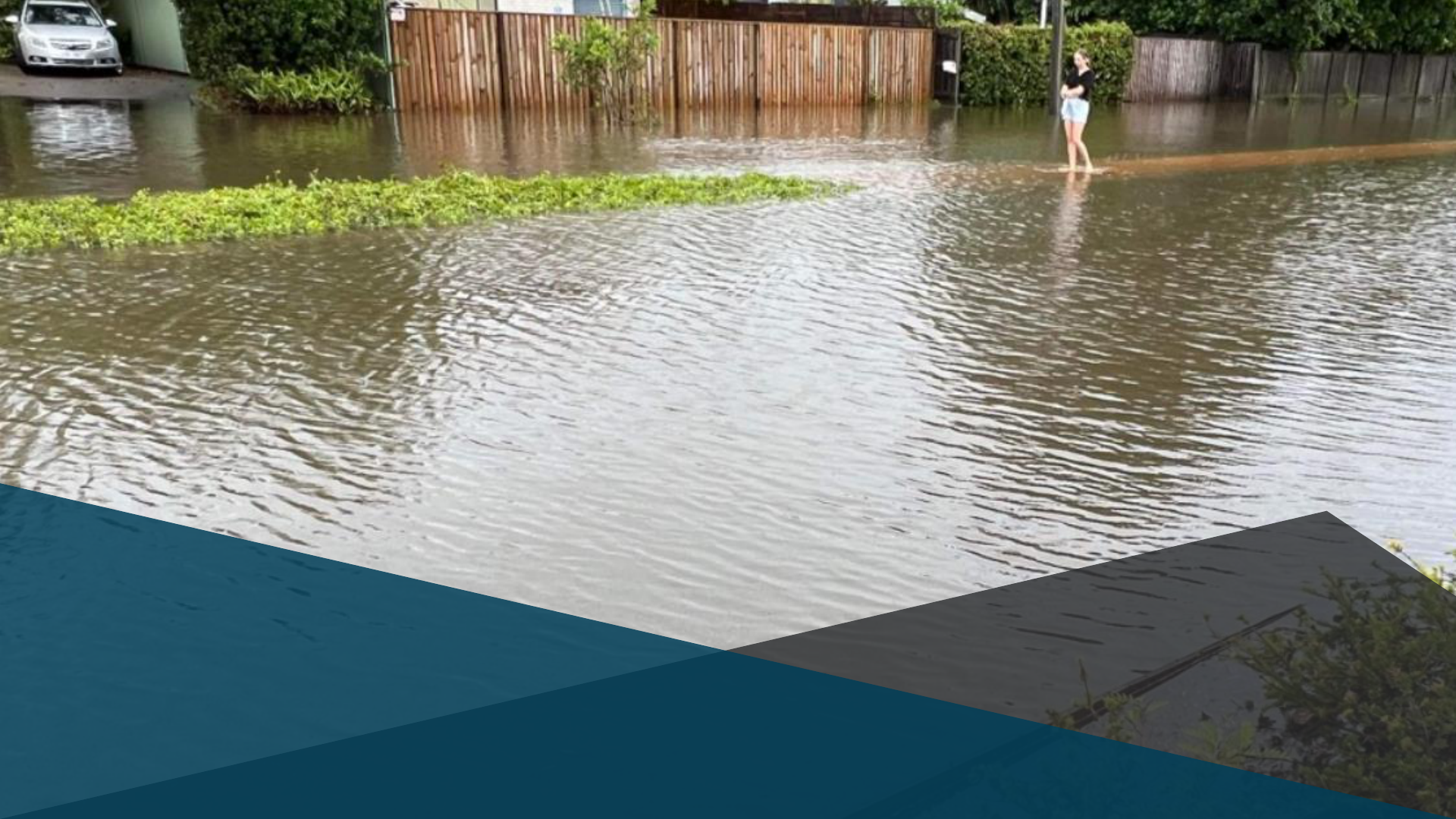
Overview
of approach.
Noosa Lakes Resort 26 February 2022.
Source: HLW 2022 Flood Impact Map
Sunshine Coast street.
Source: HLW 2022 Flood Impact Map
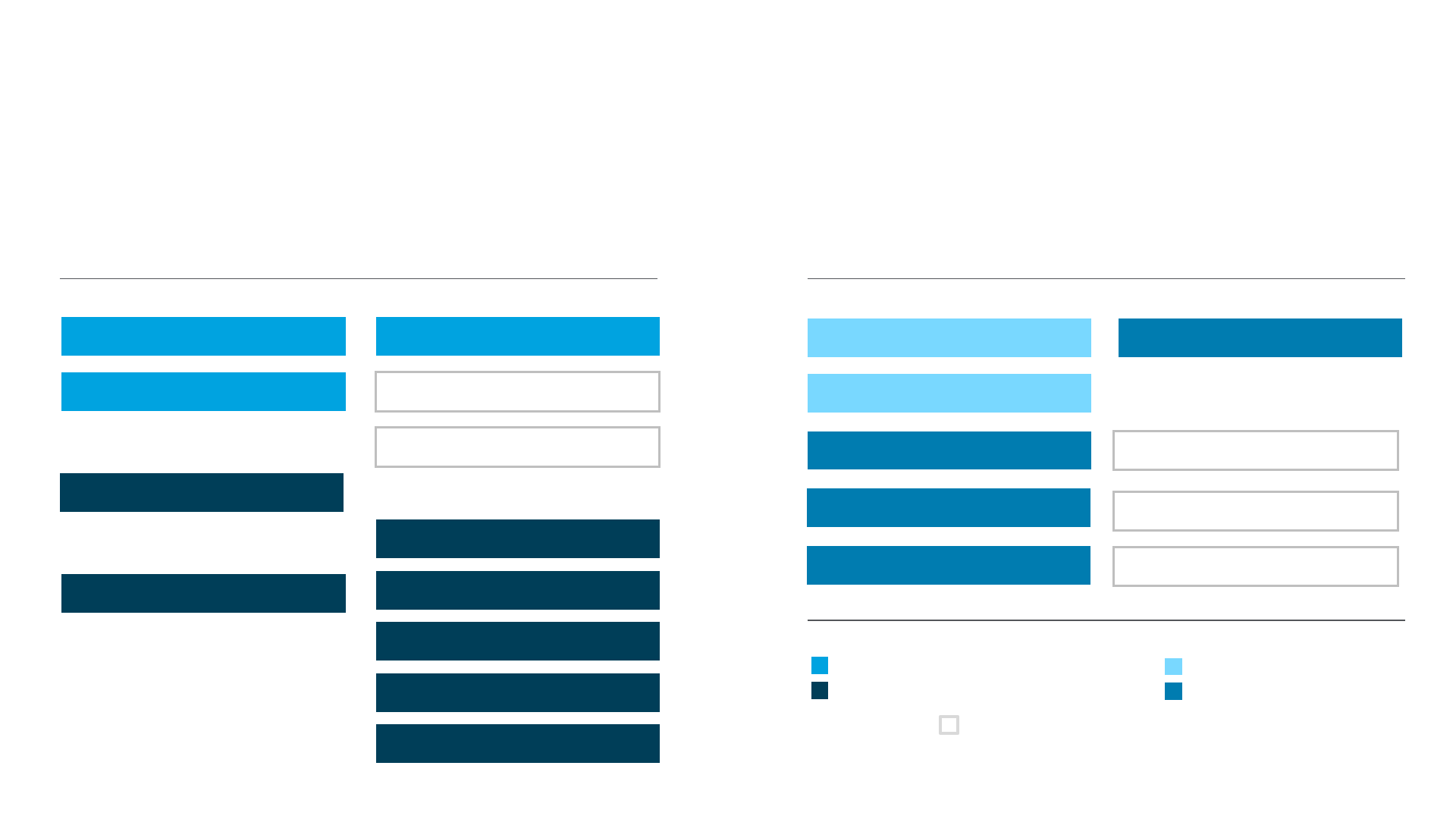
10
© 2022 Deloitte Access Economics. Deloitte Touche Tohmatsu
In order to estimate the social, financial and economic costs of the 2022 SEQ Rainfall and Flooding event, Deloitte Access Economics has utilised the following analytical framework
to categorise and analyse the costs associated with the event. This framework has been used to estimate the cost of natural disasters across Australia, including the 2011 floods in
Brisbane for QRA in the past. This framework identified two key types of costs – tangible and intangible. Within these overarching cost categories, specific costs that are relevant
and significant have been identified.
Insured losses
(residential and commercial)
Residential and commercial damage
Public infrastructure damage
Public assets and infrastructure losses
Agricultural damage
Uninsured losses
(residential and commercial)
Lost agriculture production
Lost economic activity
Emergency response and clean up
Emergency response
Temporary housing costs
Commercial clean up
Other clean up ( e.g., pest control)
Household evacuation
Business disruption
Tourism disruption
Network damage
Tangible Costs
Environmental impacts
Health
Fatalities
Injury
Mental health
Alcohol misuse
Family violence
Chronic disease
Crime
Education disruptions
Social and community impacts
Financial costs from private asset damage
Other financial costs
Death and injury
Other social costs
Items not included in cost estimates
Key
Intangible Costs
Other intangible costs
Overview of Social, Financial and Economic Costs.
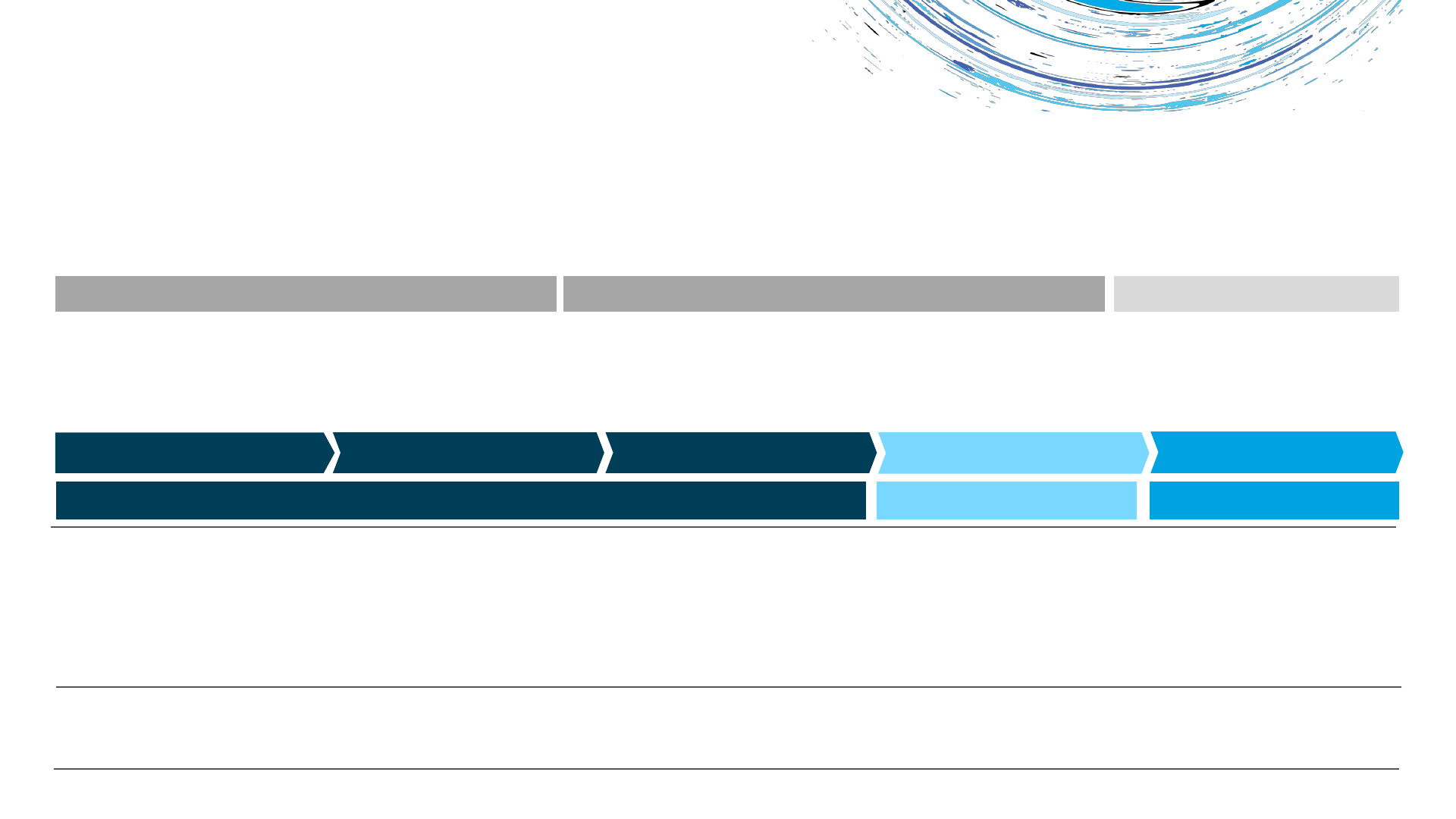
11
© 2022 Deloitte Access Economics. Deloitte Touche Tohmatsu
Approach.
Residential and commercial damage
Financial costs Social costs Total cost
Public infrastructure damage
Additional financial costs
Costs of social impact
Total cost of 2022 SEQ Floods
Residential and commercial building
damage (insured/uninsured)
Residential and commercial contents
damage (insured/uninsured)
Road damage
Government asset damage
Clean-up costs (commercial, public
building, residential, environmental)
Pest control
Lost agricultural production
Lost economic activity
Temporary housing costs
Emergency response costs
Fatalities
Injuries
Mental health impacts
High-risk alcohol consumption
Exacerbated chronic disease
Family violence
Sum of financial and social costs
Data gaps
Step 1: Estimate financial and social costs of 2022 SEQ floods Step 3: Estimate total costs
The final stage is estimate total costs.The first stage of the approach is to estimate flood-related asset
losses, other financial costs and social costs. Some costs have been
provided directly from QRA, such as damage to roads, whilst other
costs, such as the cost to mental health, have been gathered through a
literature review.
Step 2: Apply ratios
The second stage of the approach is to find ratios for the financial and social
costs. Where data gaps exist for financial costs, ratios of insured loss to other
financial costs have been applied, estimated using similar reference event
material. For social costs, incidence rates are gathered from literature, and
applied in order to estimate the additional impact of the natural disaster.
Cost of Counter Disaster OperationsWater and sewerage damage costs
To estimate the social, financial and economic costs associated with the 2022 SEQ Rainfall and Flooding event, the following methodology has been used. Largely, this methodology
consists of three main steps; 1) estimating the cost associated with each cost category, 2) estimating any ratios or incidence rates, and then finally 3) summing the financial and
social costs associated with the event. Notably, the financial costs consist of one-off costs, whilst an NPV calculation has been used for social costs given their tendency to impact
affected populations for extended periods. Refer to the Technical Appendix further detail on the approach.
The data collection process ran between 20 April 2022 and 12 May 2022. A detailed summary of these sources are provided in the Technical Appendix.
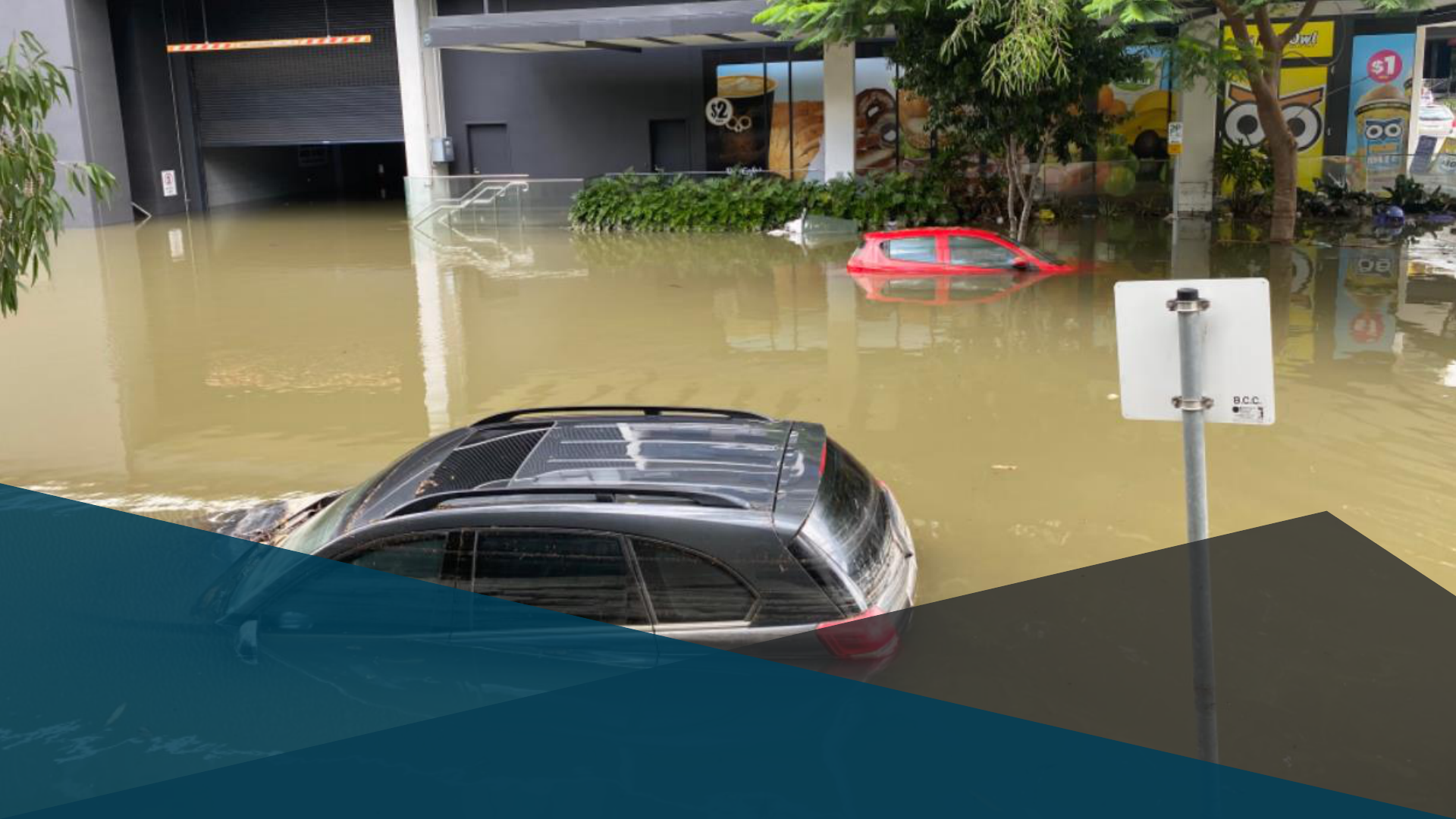
Social, Financial &
Economic Costs.
Noosa Lakes Resort 26 February 2022.
Source: HLW 2022 Flood Impact Map
Milton.
Source: HLW 2022 Flood Impact Map

13
© 2022 Deloitte Access Economics. Deloitte Touche Tohmatsu
There are a large range of costs that are associated with the 2022 SEQ Rainfall and Flooding event. Some of these have been monetised, whilst others have been discussed qualitatively in this report.
Table 1 presents a summary of the costs identified and estimated utilising the framework presented on Page 11.
Table 1 presents:
• Type of cost: whether the cost is tangible or intangible
• Damage category: the category the identified damage aligns with, based on the framework presented on Page 11
• Magnitude of impact: quantified estimation of the magnitude of the damage
• Time of impact: time of data collection for the impact, as well as the timelines for the impact
• Cost: the total estimated monetary cost associated with the damage category
• Time of cost: indicates whether the damage is a one-off cost, or if it will continue to have impacts into the future
Type of cost Damage category Magnitude of impact Time of impact Cost Time of cost
Tangible Residential and
commercial damage
• Approximately 18,000 homes and businesses affected, with 10.9% classified as being severely
damaged, and 15.1% classified as being moderately damaged.
• As of April 13, 78,845 property related claims were made to the ICA
• 11,797 motor vehicles related claims were made to the ICA
• $1.38 billion in insured losses according to the ICA
• 46.8% ratio of insured to uninsured loss value has been estimated
Data collected between
March and May. Data
collection is ongoing
$2.0 b Historical, one-off
Tangible Public
infrastructure
damage
• Around 1,718 km of state-controlled roads closed or restricted. Two roads remain closed for
major repairs due to significant landslips
• 19 Brisbane ferry terminals were damaged, with six requiring major repairs
• The ferry fleet sustained damage, with one sinking
• Estimated $20 million in costs of repairs to ferry terminals
• 20,000 households placed an Essential Services Hardship Assistance Grant claim for the loss of
an essential service, such as power
• 17 TAFE campuses were forced to close due to damage, with one campus estimating $200k in
repair costs
• 3,050 repair work orders for social housing properties
Data collected between
March and May. Data
collection is ongoing
$492 m Historical, one-off
Table 1: Summary of Costs
Summary of costs.
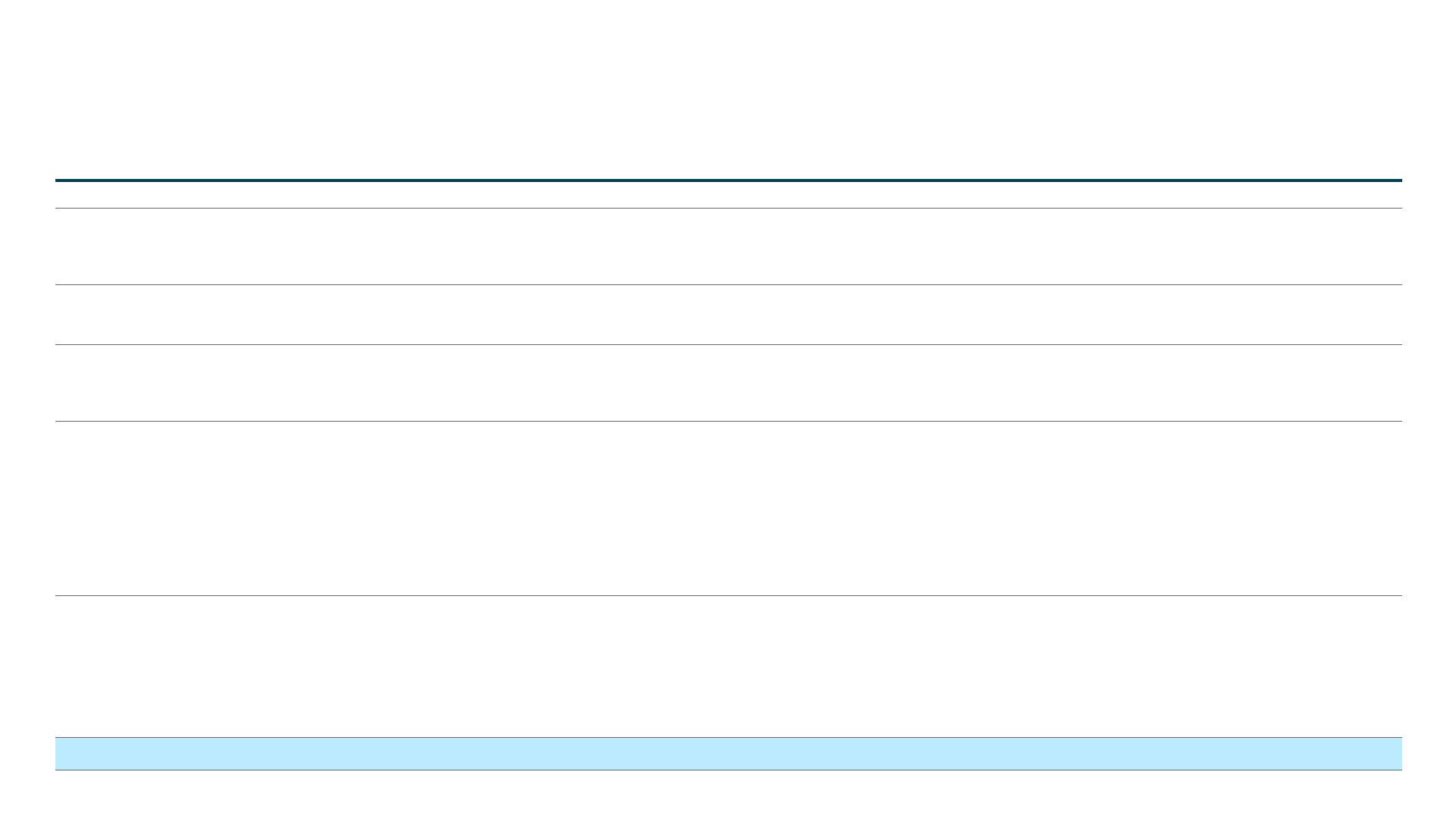
14
© 2022 Deloitte Access Economics. Deloitte Touche Tohmatsu
Type of cost Damage category Magnitude of impact Time of impact Cost Time of cost
Tangible Lost economic
activity
• 4,579 (97%) respondents to a DESBT Small Business Survey indicated they were impacted by the event
• Approximately 4,145 employees impacted by the event
• Of the respondents, 62% were forced to close for a period of time
• Over 3,000 grant applications were made for support for small businesses
Data collected between
March and May. Data
collection and impact is
ongoing
$324 m Historical, one-off
Tangible Agricultural
damage
• The Department of Agriculture and Fisheries has estimated the impact to agricultural production to be
30% of the total value of production
• 17 LGAs, and 2,250 primary producers affected
Value estimated for this
financial year. Impact is
ongoing
$254 m Historical, one-off
Tangible Emergency
response and
clean-up costs
• Evacuation and temporary housing support cost approximately $4 m
• Significant damage to the infrastructure and the environment within the affected LGAs also carries a
large response and clean-up cost of $42 m
• 101,845 emergency response grant claims were made (equating to $18 m in PHAS support)
Data collected between
March and May. Data
collection is ongoing
$65 m Historical, one-off
Intangible Human, social
and community
impacts
• Over 500,000 persons estimated to have been affected by the event in some way
• 13 fatalities occurred, with almost 200 injuries estimated
• 22,000 psychological first aid visits made across the LGAs
• Over 29,000 calls were made to the Community Recovery Hotline for support
• Over 17,000 contacts made at Community Recovery Hubs
• Cost of fatalities and physical injury estimated at $84 m
• Cost of mental health impacts estimated at $1.9 b
• Cost of alcohol misuse estimated at $18 m
• Cost of chronic disease estimated at $1.7 m
• Cost of family violence estimated at $0.8 m
Data collected between
March and May. The
impact to health and
communities is ongoing
$4.5 b Fatalities and injuries
are a one off-cost
Health impacts are
expected to impact
affected populations
over their lifetime
(see Appendix)
Intangible Other social
impacts
• QBuild has created 2,971 repair work orders at Education facilities, with 198 being for significant
damage
• State and non-state schools were closed across 13 LGAs on Monday 28 February
• Six SEQ schools were closed until the commencement of Term 2
• A total of 1,030 police personnel were deployed to assist flood affected areas
• A total of 10 persons on 14 charges were arrested in relation to anti-looting offences
• 50 million tonnes of sediment was moved through catchments from rain and flood water
• An estimated 30,000 cubic metres of rubbish was dropped at council tips and recycling centres
Data collected between
March and May
– While not costed,
social impacts are
likely to be long
lasting
Total $7.7b
Table 1: Summary of Costs (cont.)
Summary of costs.
Note: some numbers may not add due to rounding.

15
© 2022 Deloitte Access Economics. Deloitte Touche Tohmatsu
Figure 3: Insured and uninsured loss
Rainfall and flood events have significant impacts on homes and properties. The damage of flood
waters and debris carry high costs, and as such residential and commercial damage represents one of
the highest costs associated with the 2022 SEQ Rainfall and Flooding event.
Across SEQ, approximately 18,000 homes and businesses were affected by the floods, with 10.9%
classified as being severely damaged, and 15.1% classified as being moderately damaged. As such, as
of April 13, the Insurance Council of Australia (ICA) reported a total of 97,329 claims, with 78,845 claims
being property related. Overall, these claims amount to $1.4 billion in insured residential and
commercial losses.
However, this insured value does not reflect the total value of losses sustained by the affected
population. Many of the affected population are likely to be uninsured, or underinsured, meaning that
the insured loss value undervalues the cost of the floods to residential and commercial properties.
The long term impact of flooding events of this magnitude is that insurance premiums will rise further
for residents and businesses operating in flood prone areas.
1
A report by the ACCC in 2019 found that
home contents and strata insurance is becoming increasingly unaffordable in Northern Australia.
2
The
report found that home and contents insurance premiums in Northern Australia are, on average, more
than double those in the rest of Australia. As a consequence, there are high rates of non-insurance
and underinsurance in these areas. While SEQ is outside this report’s definition of Northern Australia,
it would be fair to assume that the rising costs of premiums in SEQ are likely to similarly result in
higher proportions of non-insurance and underinsurance.
An estimated ratio of insured losses to uninsured losses developed by Deloitte Access Economics was
applied to the total ICA data. This provided an estimated total uninsured residential and
commercial loss of $646 million. A sensitivity analysis on this assumption is provided in the
technical appendix.
Combined, the total estimate for residential and commercial damage is $2 billion.
1
AHURI. (2022). Brief: Floods and the future for housing insurance.
2
ACCC (2019), High premiums leading to rise in uninsured homes in northern Australia.
Residential and Commercial Damage.
$1.36 billion
in insured residential and
commercial losses
78,845
residential and
commercial
property claims
11,978
motor vehicle
claims
6,506
“other” claims
$646 million
in uninsured residential
and commercial losses

16
© 2022 Deloitte Access Economics. Deloitte Touche Tohmatsu
Damage to public infrastructure assets across SEQ was extensive. Data on this damage category was
relatively limited, with the financial costs of damage to infrastructure such as telecommunications, water
and sewerage, currently unknown. However, using damage estimates for roads and some government
assets, it is estimated that the total public infrastructure damage is approximately $492 million.
Notably, this is likely an underestimation due to the noted data limitations.
Roads damaged
Heavy rainfalls and flood waters caused significant damage to state roads across the affected LGAs, with
1,718 km of state-controlled roads closed or restricted due to damage. Rain-induced landslips also caused
widespread pavement damage and scouring around bridges and culverts. This required emergency works
in order to repair these roads and enable them to be used again in a timely manner. Beyond the financial
cost of repair, damaged roads also carry large flow-on effects as roads are essential for trade.
Road damage was only made worse due to the fact that SEQ has experienced 3 major disaster events in
the past year, wearing away at many of the roads in the region. This has meant that large sections of SEQ’s
network have been closed on numerous occasions over the past year, only working to compound the
flow-on effects to trade and business operations. As of early-May, two roads remained closed for major
repairs within the Gold Coast hinterland due to significant landslips.
Ferry terminals
A total of 19 Council owned ferry terminals were damaged in the floods, with six requiring major repairs.
16 of those terminals withstood substantial structural damage despite inundation and striking from
debris. The fleet had varying degrees of damage, with 1 ferry sinking.
1
The current estimated cost of
repairs is $20 million across the terminal network as a whole. Had terminals not been reconstructed in a
flood resilient form as part of the Flood Recovery Program, the damage (replacement cost) of these
terminals is estimated to have been in the order of $100 million to $120 million.
2
The extent of damages led to a suspension of all ferry services which has caused significant impacts to
patron commute times and convenience and has put additional pressure on roads and other public
transport systems in absorbing this demand. Some City Cat services recommenced at the end of May,
however, some terminals remain closed due to ongoing repairs. Data on ferry patronage was not
provided to Deloitte and therefore the cost of this disruption has not been included in the cost estimates.
1
Brisbane City Council (2022) , 2022 Brisbane Flood Review.
2
Information provided by Brisbane City Council. 8 June 2022. Numbers are in 2022 dollars.
3
Koks, Elco, Raghav Pant, Scott Thacker, and Jim W. Hall (2019), Understanding Business Disruption and economic losses due to electricity
failures and flooding.
4
Queensland Rail (2022), Sunshine Coast line update – Severe weather and freight train derailment
5
Data provided by Building Functional Recovery Group. Received 3 May 2022.
Public Infrastructure Damage.
Energy infrastructure
Energy infrastructure suffered extensive damage during the 2022 Rainfall and Flooding event, resulting in
power outages across the affected LGAs.
It is estimated the total costs to energy infrastructure attributed to the flooding event are at least $12
million. In total, over 180,000 customers lost power, and almost 20,000 households put in a Essential
Services Hardship Assistance Grant claim, which is related to the loss of an essential service, such as
power, for more than five days. This indicates that around 20,000 households were without power, or
another essential service, for more than five days during the event. Many more would have been without
power for a shorter time period.
The loss of power, in itself, incurs economic and social costs as affected households are forced to find
other lodgings to wait out the power outage, or live without power for several days. Businesses impacted
by the power outages would have also experienced significant costs, with the majority forced to close until
power returned.
3
Other public infrastructure
Railways were not as severely damaged during this flooding event as in previous events. However, heavy
rainfall and flooding caused water over the tracks in several locations across SEQ, and caused the
derailment of a third-party freight train near Gympie. No serious injuries were sustained, but this incurred
significant repair costs and disrupted travel along this line for an extended period.
4
Further, rainfall and flooding across the regions also damaged and caused the closure of 17 TAFE
campuses. Training in these campuses was suspended for up to two weeks, and many defaulted to online
training. Those that did default to online, however, still incurred a cost given that students were unable to
access essential equipment located on the campuses. While the financial costs of repair have not been
fully accounted for at this stage, one TAFE campus has quoted $200,000 in repair costs due to flooding
and water damage.
Finally, social housing was also impacted by the rainfall and floods, with QBuild reporting 3,050 repair work
orders for social housing properties, where 32 of these related to significant damage. Not only does this
carry an economic cost, but it also has social implications for persons displaced from these homes whilst
repairs are undertaken.
5

17
© 2022 Deloitte Access Economics. Deloitte Touche Tohmatsu
62% of small business
survey respondents
were closed for a
period of time due
to the floods
An estimated
4,145 workers
directly impacted
due to forced closures.
An estimated $324
million in damages
to small businesses
Natural disasters can be incredibly costly to small businesses in terms of lost economic activity. Not only
did the 2022 SEQ Rainfall and Flooding event cause significant direct damage to small businesses’
premises, stock and equipment, but the disruptions caused by road closures resulted in significant losses
to businesses. Furthermore, small businesses are often more vulnerable to the costs of natural disasters
than larger businesses, as they are often less adaptable and less likely to have insurance to cover
disruptions.
As of 27 April 2022, 4,709 small businesses responded to the Small Business Survey, conducted by the
Department of Employment, Small Business and Training (DESBT), with 4,579 (or 97%) of respondents
indicating that they were impacted by the floods. 4,473 of these respondents also provided an estimated
damage amount, resulting in a total estimated damage total of $324 million.
Beyond monetary damage, many respondents indicated that they had workforce issues due to the flood.
An estimated total of 4,145 employees directly impacted due to forced closures.
The damage sustained due to the floods, and the disruption caused, resulted in a significant number of
business closures for extended periods. Of the survey respondents, 62% were closed for a period of time
due to the floods. Over 60% were closed between 1 day to 2 weeks, and almost 40% were closed for over
2 weeks. 23 businesses had to permanently close.
Outside of closures, 82% of respondents indicated that the floods had impacted on their trading due to
disruption or closure. The next largest impact noted among survey respondents was damage to
equipment (37%) and damage to premises (35%).
A number of support grants were provided to businesses in order to assist emergency repairs and
provide support for small businesses and primary producers. Over 3,000 grant applications were made,
and as of 29 April 2022, the value approved was over $18 million.
Notably, this does not capture all the costs and impacts experienced by businesses. Not all affected
businesses will have responded to this survey at the time of this report, nor does it account for impacts to
larger businesses. As such, it would be fair to assume this is an underestimate of the financial costs to
businesses.
1
Davlasheridze, Meri and Pinar C Geylani (2017), Small business vulnerability to floods and the effects of disaster loans
Small Business Economics 49(4): 865-888
A Noosa café owner submitted the following
picture (right) to Healthy Land and Water,
showing how flooding impacted many SEQ
businesses.
The owner said that they had to close the café
on Saturday and Sunday due to the rain. They
were able to open on Monday to Thursday, but
no one could access the café due to road
closure. Subsequently, the café wasn’t
operating until the Friday (25 February),
resulting in 6 days of lost trade.
Source: HLW 2022 Flood Impact Map
Figure 4: Lost Economic Activity
Lost Economic Activity.

18
© 2022 Deloitte Access Economics. Deloitte Touche Tohmatsu
Agriculture damage
The heavy rain and flash flooding significantly impacted the agriculture sector across 17 LGAs. The estimated 2,250 affected primary
producers experienced a range of impacts, such as loss of fences, impacts to infrastructure and supply chains, lost cattle, devaluation of
crops, increased freight costs and severe erosion and soil loss.
1
The Department of Agriculture and Fisheries, industry groups and local governments estimate that the impact of the event is cumulatively
around 30% percent of the total value of production – around $253.5 million for this financial year.
2
Many of the affected SEQ primary producers have been hit by multiple disasters in a short period of time are struggling to recover from
continued losses.
Lockyer Valley Farmer Impacts
A Lockyer Valley Farmer submitted the following picture (right) to
Healthy Land and Water, showing how flooding impacted many SEQ
primary producers.
Around 500mm of flood water washed over the site and as a
consequence the material applied was washed away and the area
remained waterlogged, impacting pasture growth for the dairy herd.
Source: HLW 2022 Flood Impact Map
1
Queensland Government Media statement (2022) Minister for Agricultural Industry Development and Fisheries and Minister for Rural Communities, The Honourable Mark
Furner. Published 5 May 2022.
2
Information and data provided by the Queensland Department of Agriculture and Fisheries. As at 6 May 2022.
Figure 5: Agriculture Damage
Agricultural Damage.
$254.5
million
in lost
agriculture
production
2,250
impacted
primary
producers
17
affected
LGAs

19
© 2022 Deloitte Access Economics. Deloitte Touche Tohmatsu
Evacuation and housing support
As flood waters spread across SEQ, many people needed to be evacuated and rescued from
their homes. Further, the floods left many homes uninhabitable, resulting in a high need for
housing support across the LGAs. Combined, this cost was estimated to be $4 million.
Emergency clean up-costs
The damage to property and contents, and the debris and mud spread across affected areas
incurred clean-up costs. Not only did individual properties need to be cleaned, but large areas
of roads and pathways were left unusable due to mud and debris. For example, sections of
Brisbane’s Riverwalk remained closed for weeks post the flooding event, disrupting pedestrians
and cyclists who regularly use this. Given its high usage, a section of Coronation Drive was
delegated for bike only use, creating additional traffic pressure on usually heavily congested
road.
Beyond this, the floods also resulted in significant damage to the environment within SEQ.
Riverine damage was extensive, resulting in the request for $23 million to support riverine
recovery. Emergency conservation and biodiversity initiatives have also been implemented,
costing over $4 million.
Emergency clean-up represented the largest of the emergency response and clean-up costs,
with an estimated cost of $42 million. This estimate includes residential and commercial clean-
up costs focusing on clean-up, removal and disposal of flood-related debris and environmental
clean-up costs.
Emergency response grants (PHAS)
A number of financial assistance grants have been given out to the affected population in order
to alleviate personal hardship and distress suffered as a result of the SEQ floods. These
included grants to support households who were affected by the loss of essential services, such
as power, as well as those directly affected by the floods. Across the LGAs, a total of 101,845
PHAS recovery grant claims were made, with the approved claims equating to $18 million in
support so far. This has assisted a total of 93,710 people affected by the flood.
7%
65%
28%
Evauation and housing support
Emergency clean-up costs
Emergency response grants (PHAS)
There are a large range of emergency response and clean-up costs associated with any natural
disaster. The 2022 SEQ Rainfall and Flooding event occurred suddenly, and affected a wide
area in a short period of time. As such, there were significant evacuation and emergency
response costs associated with it.
The rainfall and flooding event also created significant clean-up costs, as it caused damage to
residential, commercial and public buildings, as well as covering large areas of SEQ in mud and
debris. Furthermore, the flood water caused significant damage to the environment, requiring
large scale environmental clean-up efforts as well.
Overall, the costs associated with emergency response and clean-up are estimated to be
almost $65 million.
Figure 6: Emergency response and clean-up cost by cost type
Emergency Response and Clean-Up.

20
© 2022 Deloitte Access Economics. Deloitte Touche Tohmatsu
The 2022 SEQ Rainfall and Flooding event is estimated to have numerous direct and indirect
health and social impacts on affected communities. Natural disasters can lead to fatalities and
injuries, and the traumatic nature of these events can lead to long-standing impacts on mental
and physical health (see Appendix for further detail on average life expectancy). Not all of these
impacts can be monetised, however, given their intangible nature. As such only selected impacts
have been monetised to estimate the total social cost.
With over 500,000 persons estimated to have been affected by the floods (according to ABS
population data for suburbs activated for Personal Hardship Assistance) the social and health
impacts are estimated to cost $4.5 billion. As such, Deloitte Access Economics estimates that the
social costs of this natural disaster are approximately 1.4 times the direct financial costs. Given
that the affected population data used relates only to suburbs activated for Personal Hardship
Assistance, Deloitte Access Economics recognises this may be a conservative estimate.
Fatalities and injuries
During the event, 13 fatalities occurred and it has been estimated almost 200 injuries were
suffered across the affected communities. The economic costs of these incidents have been
estimated using the value of statistical life from the Office of Best Practice Regulation, which
considers the lifetime cost of deaths and the effect of injuries on life quality. Applying this cost to
the estimated prevalence of fatalities and injuries provides an approximate cost of $84 million.
Alcohol misuse
Exposure to natural disasters can lead to risky levels of alcohol consumptions, which in turn can
have significant negative impacts on the life of affected populations.
Chronic disease
Natural disasters can exacerbate or induce chronic disease in affected populations. This can be
caused by illness or injury sustained during the disaster, or from being separated from medicine
due to road closures or other disruptions.
1
As such, this report has estimated the additional impact
of natural disasters on diabetes, chronic obstructive pulmonary disease, and stroke.
Family violence
The traumatic and high stress nature of natural disasters is correlated with an increase in domestic
and family violence. Thus, this increase carries significant health and social costs for affected
populations and communities.
Mental health
During the rainfall and flooding event, over 22,000 psychological first aid visits were made across
the LGAs to support affected populations in the aftermath of the event.
Natural disasters can have a heavy toll on mental health, often inducing grief, post traumatic stress
disorder, anxiety and depression. The traumatic experience of the event and the loss of
belongings, property, or loved ones, thus, has significant health and social costs associated with it.
2
This report quantifies the impact of natural disasters on mental health as the estimated additional
incidence of reported psychological distress across the affected population.
Overall, the health and social costs are significant with over 39,000 calls made to the Community
Recovery hotline for recovery support, and over 17,000 contacts made at Community Recovery
Hubs. Across the social and health impacts monetised, it is estimated that the total health and
social cost is approximately $4.5 billion.
Figure 7: Social cost by peril type ($bn)
1
Miller, A. and Bonnie Arquilla (2012), Chronic Disease and Natural Hazards: Impact of Disasters on Diabetic, Renal and Cardiac Patients
Prehospital and Disaster Medicine 23(2): 185-194
2
Makwana, N. (2019), Disaster and its impact on mental health: A narrative review, Journal of Family Medicine and Primary Care
$- $1 $2 $3 $4 $5
2022 SEQ Floods
Fatality Physical injury
Mental health (psychological distress) Alcohol misuse
Chronic disease Family violence
Human, Social and Community Impacts.
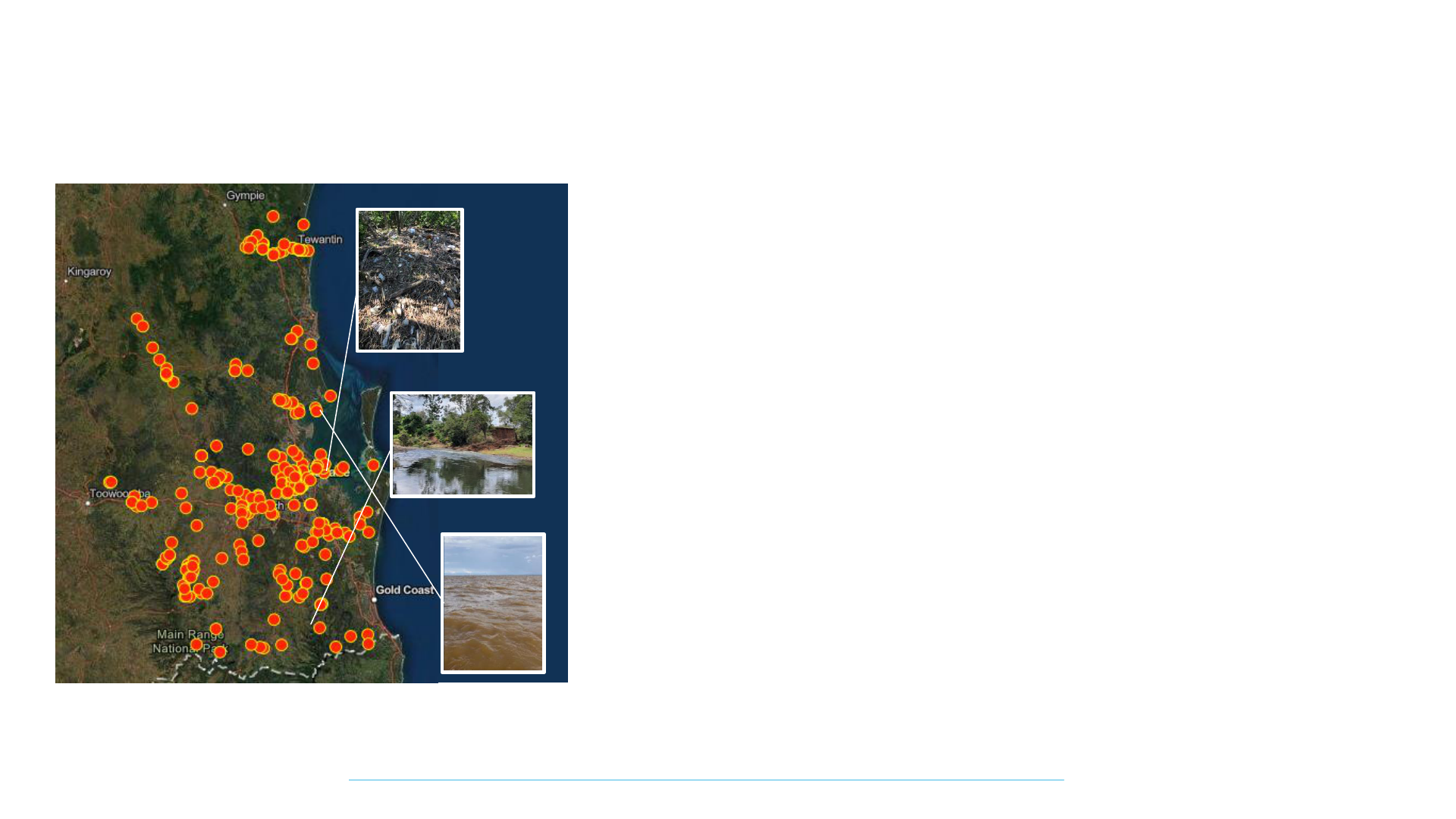
21
© 2022 Deloitte Access Economics. Deloitte Touche Tohmatsu
Education disruption
QBuild has created 2,971 repair work orders at Education facilities; 198 of these are for significant damage. A
total of 613 Education facilities were impacted.
1
On Monday 28 February, state and non-state SEQ schools were closed across 13 LGAs. Although the schooling
system has the ability to quickly deliver at-home schooling after COVID-19 lockdowns, this still caused disruption
to students’ education. Further, 6 SEQ schools were closed until the commencement of Term 2.
2
A 2020 OECD study revealed that students affected by school closures (due to COVID-19 lockdowns) may
receive 3% lower income over their entire lifetimes – amounting to 1.5% lower annual GDP for the remainder of
the century.
3
Although the school closures in the 2022 SEQ Floods were minor in comparison to the education
disruption of the 2020 lockdowns, the research indicates that school closures carry a economic cost.
3
Crime
The Queensland Police Service commenced Operation Uniform Nash on 1 March 2022 with a focus on
preventing and disrupting crime-related offences relating to the 2022 SEQ Rainfall and Flooding event. A total of
1,030 police personnel were deployed to provide assistance to flood affected areas, consisting of 9,270 patrol
hours. By its closure on 10 March 2022, a total of 10 persons, on 14 charges, were arrested in relation to anti-
looting offences.
4
Environmental damage
Heavy rainfalls and flood waters caused extensive degradation of waterways including riparian areas, riverine
ecosystems, species habitat and productive agricultural lands. An estimated 50 million tonnes of sediment
moved through catchments from rain and flood water, with 1-5 tonnes of sediment potentially impacting
Moreton Bay. The nutrient concentrations in water have been found to be substantially higher than 2011 flood
levels. The access water caused the further spread of invasive species including weeds, feral pigs and mosquito
borne disease e.g. Japanese Encephalitis. The costs associated with pest and disease clean-up is captured on
Page 19.
5
The flow of water carried years’ worth of landfill into Queensland water ways. Brisbane City Council estimated
that 30,000 cubic metres of rubbish was dropped at council tips and recycling centres.
6
Healthy Land and Water impact tool – 2022 SEQ flooding
Due to data limitations, these impacts were not monetised and included in the social, financial and economic cost estimates.
1
Data provided by Building Functional Recovery Group. Received 3 May 2022.
2
Queensland Government Media Statement (2022). Minister for Education, Minister for Industrial Relations and Minister for Racing The Honourable Grace Grace. Published 27 February 2022.
3
Hanushek, E. A., & Woessmann, L. (2020). The economic impacts of learning losses.
4
Data provided Queensland Police Service. Received 6 May 2022.
5
Data provided by the Queensland Department of Environment and Science. Received 11 May 2022.
6
Adrian Schrinner Lord Mayor of Brisbane Statement (2022). https://www.theguardian.com/australia-news/2022/mar/09/qld-and-nsw-floods-create-mountains-of-waste-and-spark-environmental-and-vermin-fears
Human, Social and Community Impacts.
Rubbish, Port of Brisbane
Deception Bay Flood Plume
Erosion along Canungra Creek
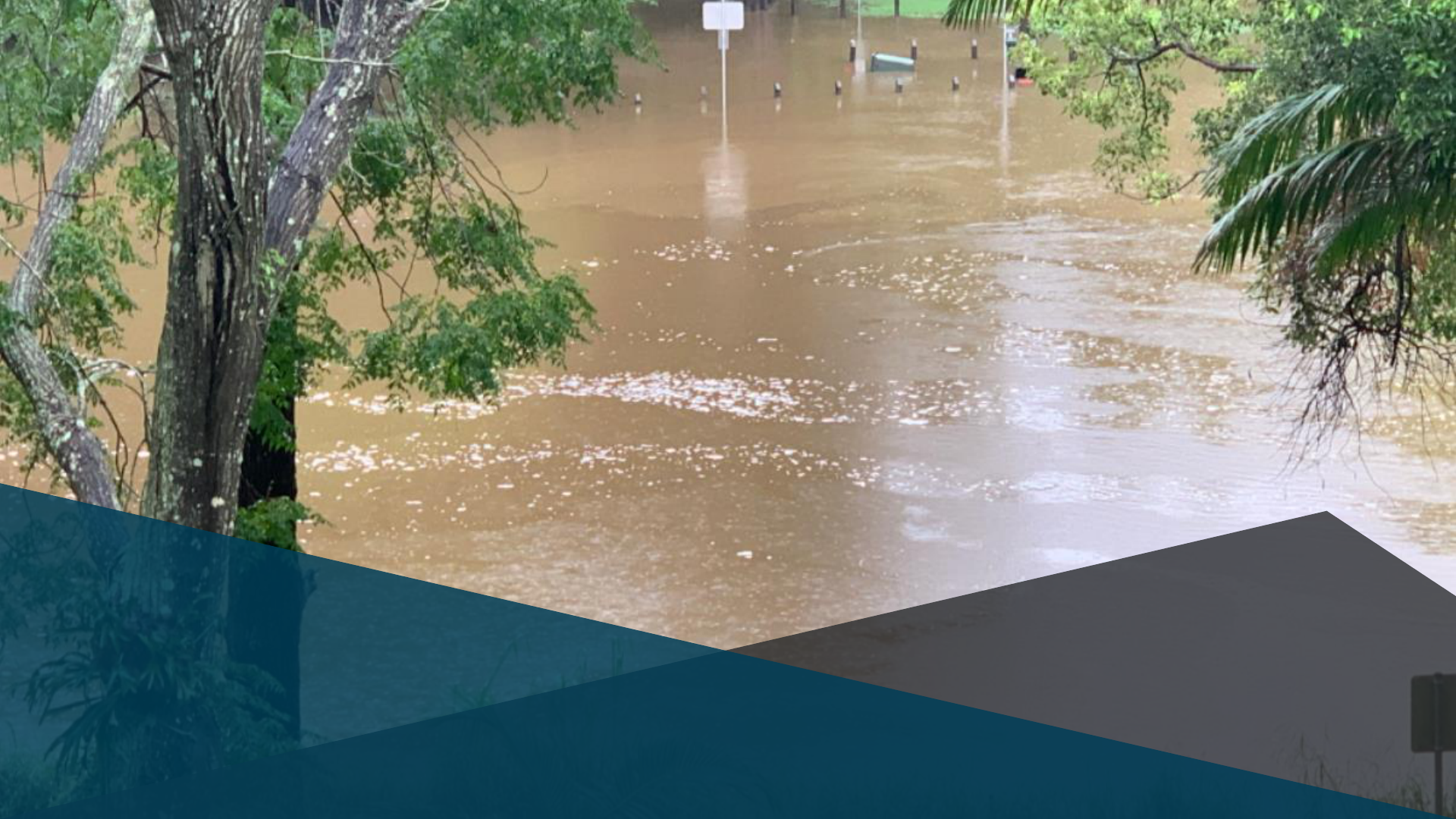
Regional
Impacts.
Noosa Lakes Resort 26 February 2022.
Source: HLW 2022 Flood Impact Map
Bunya Crossing Reserve, Eatons Hill.
Source: HLW 2022 Flood Impact Map

23
© 2022 Deloitte Access Economics. Deloitte Touche Tohmatsu
Overview
Recent AHURI research states that 66 per cent of people consider the impact of flooding as an
important determinate as whether to move to a regional city. As such, the event may impact
people’s perception of liveability in moving to regional cities and towns within SEQ.
1
The impact of the 2022 South East Queensland Rainfall and Flooding Event was significant for all
SEQ regions, with the scope and scale of these impacts differing among the characteristics of each
LGA. One approach to understanding these regional impacts is to distinguish between different
types of regions:
Built up residential areas are densely populated, meaning that the majority of rainfall and flooding
impacts relate to residential housing, public infrastructure and mental heath impacts (driven by the
density of population). In contrast, the impacts in built up commercial areas (i.e. CBDs) largely
pertain to reduced economic activity, damaged commercial infrastructure, loss of stock and public
infrastructure damage. There are some suburbs (e.g. Brisbane City) that can be categorised both
as built up residential and commercial, while some LGAs encapsulate all three categories (e.g.
Gympie is highly commercial in the centre, with residential pockets and agriculture areas
surrounding the city.)
Agriculture areas, such as the Lockyer Valley, incurred significant impacts relating to the agriculture
industry, which dominates the regional economy. The rainfall and flood impact largely related to
losses in agriculture production and damage to agriculture infrastructure.
These impacts are discussed through case studies for Gympie, Ipswich and Lockyer Valley.
Agriculture areasBuilt up
commercial areas
Built up
residential areas
Gympie
The 2022 South East Queensland Rainfall and Flooding Event was the worst flooding event that
Gympie has experienced in over a century. During the event, the Mary River reached 23m (the
highest level since 1893) and floodwaters inundated 800 properties.
2
On 26 February 2022, an evacuation order was made for the area of Gympie as life-threatening
floods continued to inundate the region. During the event, Over 460 residents were
accommodated across four evacuation centres.
3
Despite extensive recovery efforts, hundreds
of residents and remained displaced a month after the floods, with some homeless.
4
The impacts to the Gympie region are diverse and wide ranging. Primary producers suffered a
loss of pasture, crops and topsoil as well as impacts on livestock and damage to stored inputs.
5
Nolan Meats, a family-owned company in the region, estimated that the cost of flood damage
and stock loss hit at around $15 million.
6
Businesses in the Gympie CBD were also severely impacted, with water levels reaching the
ceiling of some businesses. The event compounded the economic impacts of COVID-19 and
recent natural disasters for businesses in the area. One Mary Street business owner indicated
that they would not reopen after the event, after servicing the community for over 24 years.
7
When businesses close rather than recover, there are long-lasting community impacts that
carry a significant cost to the region. In addition, several not for profit retail shops were
inundated by floods (e.g. Little Haven Palliative Care Market Place, Neighbours Aid Gympie Op
Shop, RSPCA Op Shop) with resultant revenue loss.
It has been observed within the community that the psychological distress and anxiety of the
floods were compounded by mental health impacts of COVID and previous bushfires and
drought in region.
8
In the midst of recovery, Gympie has once again been hit by flooding. On Sunday, 15 May,
Gympie was cut off after the town was inundated by floodwater and the Mary River reached
15.56 metres. This is the third major flooding event for the town in five months, with cumulative
impacts being observed among local businesses and community groups.
9
As the region
continues to be impacted by natural disasters, it loses its resilience to future stocks, extending
recovery and compounding impacts to the region.
1. AHURI. (2022). Brief: Floods and the future for housing insurance.
2. https://www.abc.net.au/news/2022-05-13/qld-wet-weather-heavy-rain-flash-flooding-bom-warning/101061852
3. Gympie Regional Council (2022). Local Recovery Plan.
4. https://gympietoday.com.au/rural/2022/03/10/bank-to-help-flooded-farmers/
5. https://www.abc.net.au/news/2022-03-28/gympie-flood-recovery-residents-homeless-amid-housing-shortage/100938470
6. https://www.couriermail.com.au/news/queensland/gympie/nolan-meats-say-gympie-flood-losses-could-be-15m/news-story/8e40d5c187cfddb6242062db9b426890
7. https://www.abc.net.au/news/2022-03-10/calls-to-relocate-gympie-cbd-after-latest-flood/100898230
8. Gympie Regional Council (2022). Local Recovery Plan.
9. https://www.brisbanetimes.com.au/national/queensland/greater-brisbane-asked-to-save-water-as-gympie-assesses-flood-damage-20220515-p5aleq.html
Regional impacts.

24
© 2022 Deloitte Access Economics. Deloitte Touche Tohmatsu
Ipswich
Ipswich is the fastest growing city in Queensland, but its residents endured significant damages
in the 2022 SEQ Rainfall and Flooding event. Between February 25 and 28, Ipswich received
682mm of rain, and the 224mm recorded on February 26 was the highest daily total since
1974.
1
The onslaught caused the Bremer River to rise to 16.72m, eclipsed only by the
respective 1974 and 2011 peaks of 20.7m and 19.4m.
Currently, Ipswich is characterised by a highly constrained housing market, with vacancy rates
as low as 1% in some areas. This is largely due to the growing population, but is also related to
the past Halloween Hailstorm in 2020, which impacted over 1,700 homes, displacing many
residents and resulting in many of those homes still under repair to this day. As such, previous
natural disasters have compounded the cost of this rainfall and flooding event and exacerbated
the area’s housing crisis.
The 2022 SEQ Rainfall and Flooding event affected the Ipswich area in a broad range of ways.
Costs were widespread, with over 500 houses and over 300 businesses damaged.
2
In heavily
affected areas, like Goodna, previous floods made some properties uninsurable, compounding
the cost of the 2022 SEQ flooding for these residents. Not only were property physically
damaged, but the event also had severe impacts on mental and physical health, businesses,
and the environment. Specifically, some of the impacts noted in the local recovery plan include:
• Resupply access to essential food, medical supplies and fuel as a result of road and business
closures
• Psychosocial impacts on community as a result of evacuations and requirement for
temporary accommodation due to inundation
• Roughly 250-300 businesses impacted to varying degrees
• Flood debris moving through the river catchment impacted water quality
• 95 council-controlled roads were closed across Ipswich
Lockyer Valley
The Lockyer Valley is known as a ‘food bowl’ for its cultivation of various grains, vegetables and
breeds of livestock. Its low-lying areas were significantly damaged during the 2022 SEQ floods.
Gatton, a central town in the region, recorded its highest ever daily rainfall total of 302mm on
February 26. Total rainfall between February 25 and 28 amounted to 531mm.
3
Rainfall and floodwaters caused an estimated $5 million in damage to critical roads in the area.
Further, over 100 homes suffered damage, and the disruption had broad negative effects on
primary producers. Waste and weeds washed onto produce has affected their quality,
deceased livestock or been misplaced, and flood debris has damaged farm infrastructure like
unpaved roads and fences.
4
These are expected to have delayed consequences come harvest season that will exacerbate
the long-term cost of flooding for the Lockyer Valley region. As an example, due to the rainfall
and flooding event, lettuce crops were ruined across some farms, whilst other farmers weren’t
able to fertilise their crops. This has constrained lettuce supply in SEQ and drastically increased
the cost of lettuce.
5
The impacts of the floods on Lockyer Valley were varied, some of the impacts specifically noted
in the local recovery plan include:
• Cumulative psychological impacts on the community, businesses and agricultural industry,
due to COVID-19, bushfires, drought and major flooding events which have occurred in
2011, 2013, 2017 and now in 2022.
• Small businesses and primary producers sustained damage, disruptions and financial losses
• Damage to ecosystems within the creek catchments, as well as soil erosion and sediment
build up
• 70% of the unsealed road network needs repair work
• Rail line was damaged, with lines disrupted
1
Bureau of Meteorology (BOM) (2022), Daily rainfall: Ipswich Alert
http://www.bom.gov.au/jsp/ncc/cdio/weatherData/av?p_nccObsCode=136&p_display_type=dailyDataFile&p_startYear=&p_c=&p_stn_nu
m=040831
2
City of Ipswich (2022), Interim Local Recovery Plan: Flood Event February 2022
Regional impacts.
3
Bureau of Meteorology (BOM) (2022), Daily rainfall: Gympie Alert
http://www.bom.gov.au/jsp/ncc/cdio/weatherData/av?p_nccObsCode=136&p_display_type=dailyDataFile&p_startYear=&p_c=&p_stn_nu
m=040993
4
Lockyer Valley Regional Council (2022), February 2022 Flood Recovery Plan
5
Read, Michael (2022), Tip of the iceberg: why lettuce could get even more pricey
https://www.afr.com/policy/economy/tip-of-the-iceberg-why-lettuce-could-get-even-more-pricey-20220509-p5ajos
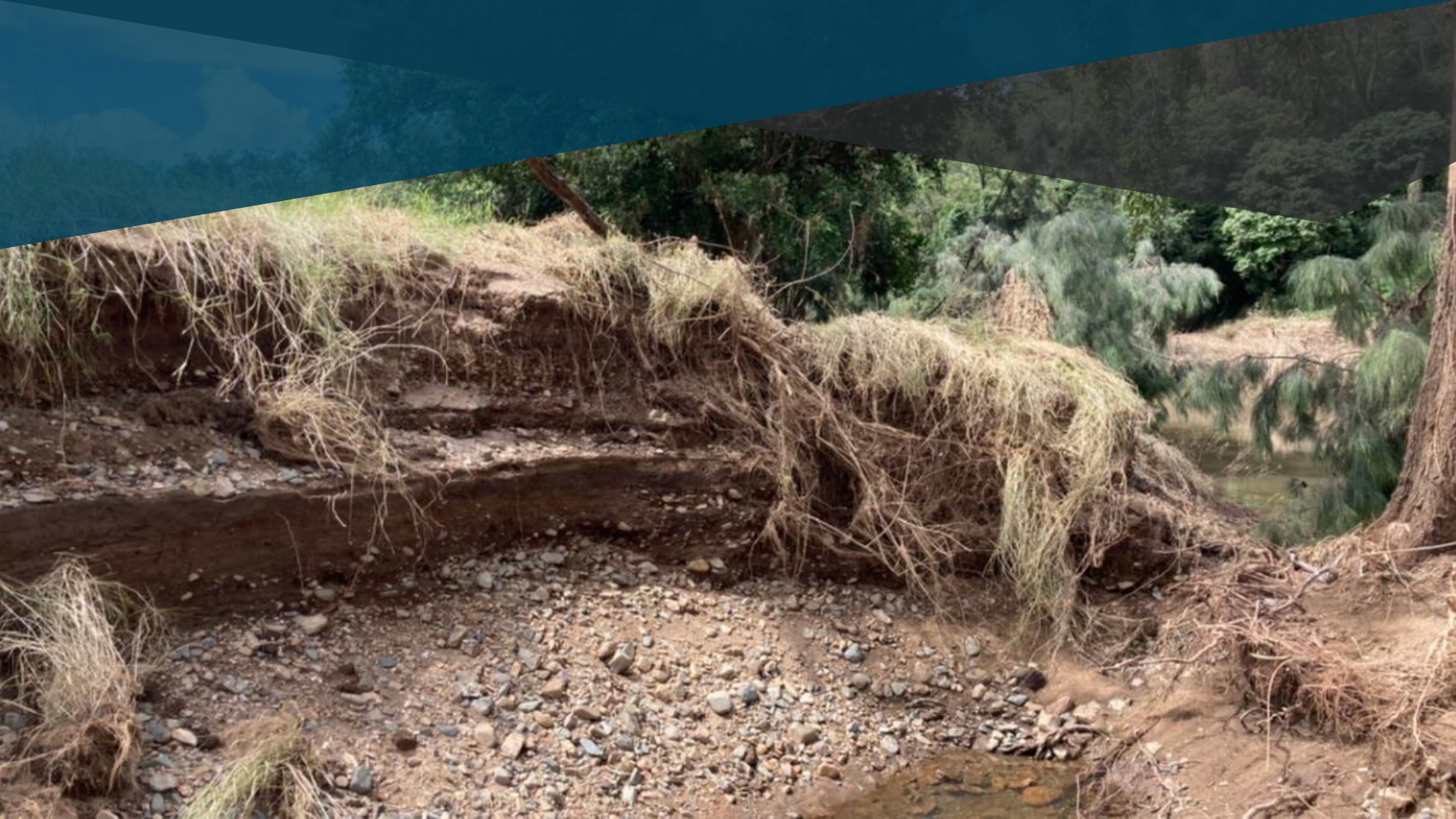
Noosa Lakes Resort 26 February 2022.
Source: HLW 2022 Flood Impact Map
Technical
Appendix.
Stream bank erosion - Cedar Creek.
Source: HLW 2022 Flood Impact Map
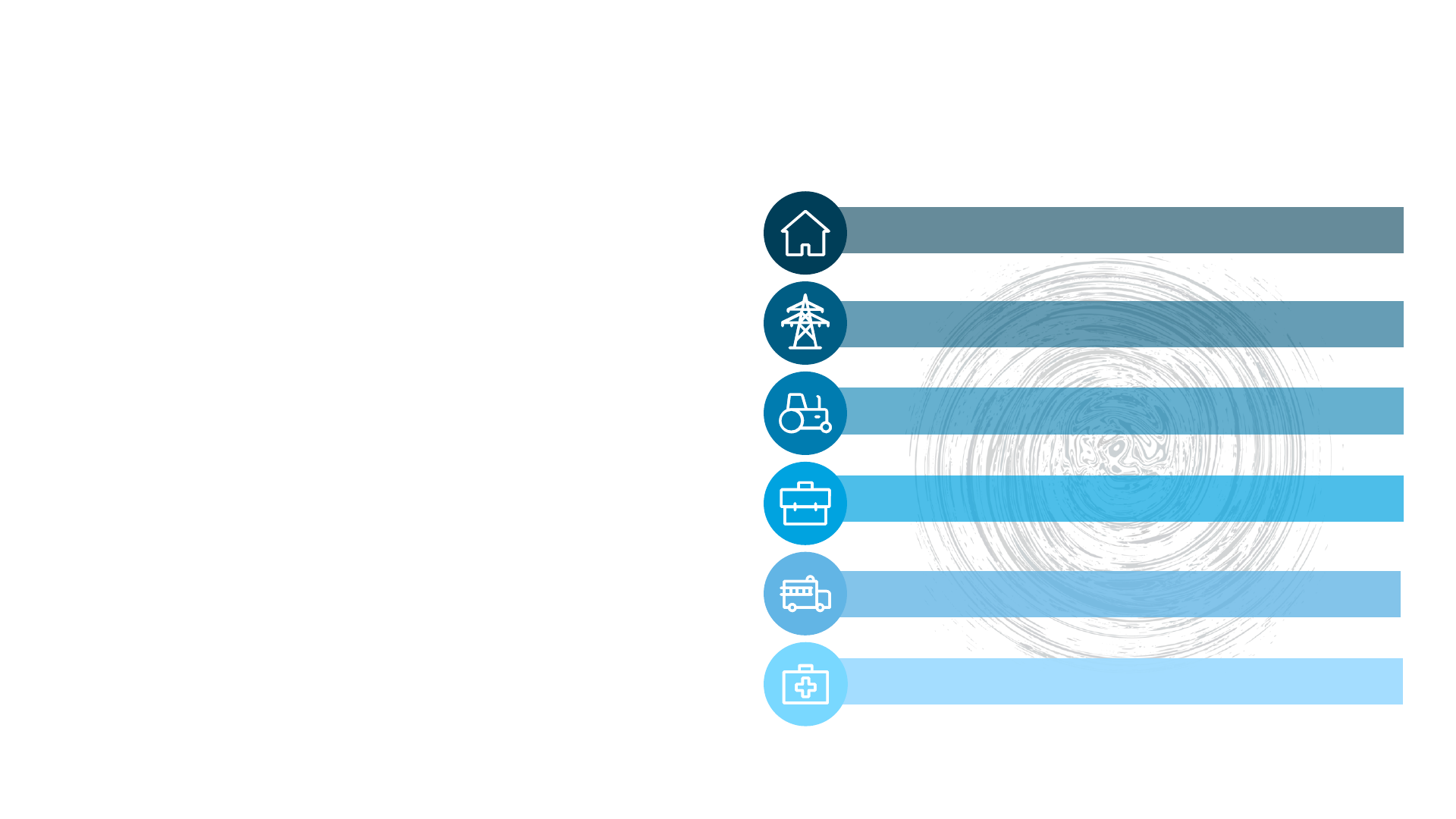
26
© 2022 Deloitte Access Economics. Deloitte Touche Tohmatsu
Technical Methodology.
Overview
The methodology utilised in this paper is aligned to methodologies used by Deloitte Access
Economics in previous costings of natural disasters. Specifically, the approach taken has drawn
on the following reports:
• A BTE 2001
1
report which developed a framework for estimating the economic cost of
natural disasters. This report has become a standard piece of literature to inform
approaches and methodologies in costing natural disasters.
• Deloitte Access Economics’
2
report commissioned by the Australian Business
Roundtable to estimate the economic cost of the social impact of natural disasters. This
report revised the BTE framework to enable the estimation of broader, longer-term social
costs of natural disasters, including impacts on health and wellbeing.
• Deloitte Access Economics’
3
report which utilised this established methodology and
applied it to the Monsoon Trough in 2019. This report utilised a bottom-up approach to
costing the disaster, whilst also applying the ratios developed in previous reports to fill in
data gaps.
This approach has been refined and validated over time, and has now been applied to 2022
SEQ floods in order to estimate the tangible and intangible costs associated with the flood
disaster. These are defined as follows:
• Intangible costs are the direct and indirect impacts that cannot be easily monetised.
These can include the social costs associated with fatality, injury, and disease. These costs
tend to persist over a person’s lifetime.
• Tangible costs are the direct and indirect impacts that are easily monetised. These costs
are often one-off costs that are associated with the natural disaster being investigated.
These can include the financial costs associated with infrastructure damage, contents
damage, business disruption and clean-up costs.
See Figure 8 for an overview of the costs included in this estimation.
Residential and commercial damage
Public infrastructure damage
Lost agricultural production
Lost economic activity
Emergency response and clean-up
Health, social and community impacts
Figure 8: Monetised costs in this report
1
Bureau of Transport Economics (2001), Economic costs of natural disasters in Australia.
2
Deloitte Access Economics (2016) , The economic cost of the social impact of natural disasters.
3
Deloitte Access Economics (2019), The social and economic cost of the North and Far North Queensland Monsoon Trough.

27
© 2022 Deloitte Access Economics. Deloitte Touche Tohmatsu
Technical Methodology.
Assumptions and methodology
Population
This report has considered the social impact of the SEQ flooding event to 15 impacted LGAs.
For each LGA, suburbs within have been identified as either being not affected, or partially, or
fully activated for Personal Hardship Assistance. LGAs that have been fully activated have had
ABS 2020 population data assumed to be equal to affected population. For LGA’s that are only
partially activated, ABS 2016 suburb data has been collected and a growth rate applied to
estimate their 2020 population.
A small number of suburbs within the LGAs were identified as being partially activated. Given
the relatively small population in these suburbs, and the lack of data on the proportion of
population that was affected, it was assumed that the entire suburb should be included in the
affected population.
Estimating the incidence of social impacts
The incidence of social impacts included in this cost estimate was largely determined through a
literature review. Through this literature review, the following social impacts were identified as
having sufficient evidence to be quantified:
• Fatalities and physical injury
• Mental health issues
• Alcohol misuse
• Chronic disease
• Family violence
Notably, there was no published figures on injuries sustained in the 2022 SEQ floods. As such,
injures incurred during the 2011 floods was used as a proxy, scaled by the number of houses
affected in each disaster.
Incidence rates were derived from literature, alongside the additional impact caused by the
natural disaster. Evidence also suggests that the incidence of social impacts due to natural
disasters drops off slowly after the event occurs. As such, the incidence rate is applied fully in
the first year, and then drops by one-third every year, to 5% of the rate by the fourth year post-
disaster. This reflects the spike in social impacts associated with the event, but also evidence
that after this spike, most people will recover over the medium- to long- term. It is important to
note, however, that not everyone will ever recover from a traumatic event, such as the floods,
as such it is assumed that a small proportion of people will experience life-long impacts.
These life-long impacts are estimated using the average remaining life expectancy for the
affected population, split by Adult Male (32), Adult Female (28.5), Child Male (72) and Child
Female (76.5). This calculation utilised ABS life tables of remaining life expectancy at each age.
Beyond literature research, Household, Income and Labour Dynamics in Australia (HILDA)
survey data was also utilised to find incidence rates for certain social impacts. This was derived
from a 2017 difference-in-difference of HILDA data used in the DAE report commissioned for
the ABR, and it was assumed that the impact of floods on these social impacts is unlikely to
have changed significantly from when this analysis was last conducted. The incidence rates
derived from this analysis was compared between those who experienced a natural disaster
and those who did not to identify the additional incidence of those impacts caused by natural
disasters.
Estimating the unit cost of social impacts
A literature review was also utilised to identify the associated unit cost of each of the social
impacts quantified. Each unit cost was indexed to 2022 dollars, and multiplied by the incidence
of social impacts.
In some cases, a unit cost could not be found, however, the literature review was able to
identify the proportion of the total costs for each outcome that could be attributed to each of
the cost categories. This largely involved identifying studies that had investigated a larger
population level, and the cost by each category identified was then divided by the total cost to
determine the proportion. This proportion was then applied to the total costs of each outcome.

28
© 2022 Deloitte Access Economics. Deloitte Touche Tohmatsu
Technical Methodology.
Assumptions and methodology (cont.)
Estimating the tangible costs
Most tangible costs have been estimated by local councils, government agencies and QRA, and
then passed onto Deloitte Access Economics and included in this report. However, there were
data gaps that remained that could not be filled through reported data, given how closely this
report has followed the natural disaster event. As such, where primary data from the client
could not be used to form the tangible financial costs, these costs were estimated using the
methodology from Building our Nation’s Resilience to Natural Disasters, which calculates a number
of costs to insured losses ratios.
Given that total insured losses was able to be obtained from QRA, this report utilised previous
ratios estimated for the 2010-11 floods and applied them to financial cost categories with data
gaps. These ratios can be seen in Table 2.
Data limitations
This report largely draws upon information supplied by the QRA on the known impact of the
disaster following the event. This data was, in turn, provided to QRA by several Functional
Recovery Groups involved in response and recovery activities. This report was constructed in a
relatively short-time frame after the event, and as such data is still being collected and the full
impact is still being discovered (as an example, it can take up to three years for insurance
claims to be collected on a particular disaster event).
As such, the social and economic cost estimate derived in this report is based on available data
and information at the time of writing as at May 13 2022. This is likely a conservative estimate
given data limitations, and as such, additional data is expected to most likely increase this
estimate.
Furthermore, costs included in this report should not be considered as a ‘total cost’
assessment. Some of the costs estimated are temporary one-off costs, such as clean-up costs,
whilst others are likely to have long-lasting impacts on affected populations, such as mental
health and chronic disease. A cost-benefit analysis has not been undertaken to account for the
timing and duration of identified impacts.
% of total cost
$m (2011)
Insured
47.9
$1,266
Uninsured
22.4
$593
Cat B
26.3
$696
Agricultural production losses
0.0
$0.04
Evacuated
0.0
$0.09
Homeless
0.6
$16
Homes
– damaged
0.2
$6
Commercial
– damaged
0.0
$1
Emergency response costs
2.5
$65
Total
100
$2,644
Table 2: Tangible cost estimates for 2010-11 Queensland Floods
Source: Deloitte Access Economics, The Economic cost of the social impact of natural disasters (2016)
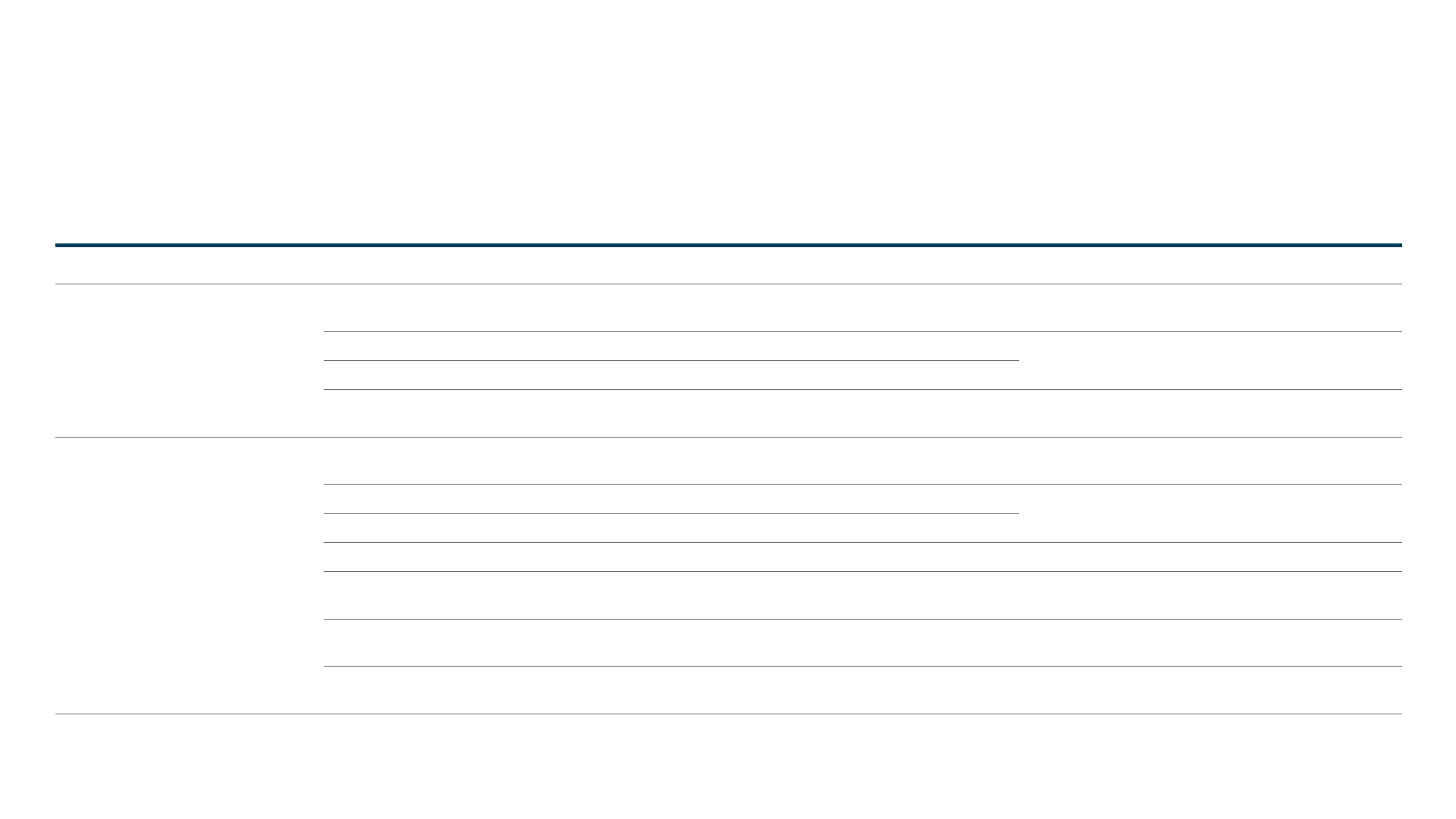
29
© 2022 Deloitte Access Economics. Deloitte Touche Tohmatsu
Technical Methodology.
Data from Queensland Government agencies was requested in reference to the South East Queensland Rainfall and Flooding event only (22 February – 5 April 2022). The data collection process ran
between 20 April 2022 and 12 May 2022. The specific dates of data provided to Deloitte Access Economics, is specified below.
Type of cost
Damage category
Magnitude of impact
Source
Tangible
Residential and
commercial damage
•
Approximately 18,000 homes and businesses affected, with 10.9% classified as being severely
damaged, and 15.1% classified as being moderately damaged.
Department of Communities, Housing and Digital
Economy. Received 21 April 2022.
•
As of April 13, 78,845 property related claims were made to the ICA
Building Functional Recovery Group. Received 3 May
2022.
•
11,797 motor vehicles related claims were made to the ICA
•
46.8% ratio of insured to uninsured loss value has been estimated
DAE, The economic cost of the social impact of natural
disasters.
Tangible
Public infrastructure
damage
•
Around 1,718km of state-controlled roads closed or restricted Two road remain closed for major
repairs due to significant landslips
Department of Transport and Main Roads. Received 5
May 2022.
Update received 8 June 2022.
•
19 Brisbane ferry terminals were damaged, with six requiring major repairs
Brisbane City Council (2022), 2022 Brisbane Flood
Review.
•
The ferry fleet sustained damage, with one sinking
•
Estimated $20 million in costs of repairs to ferry terminals
Brisbane City Council. Received 7 June 2022.
•
20,000 households placed an Essential Services Hardship Assistance Grantclaim
for the loss of an
essential services, such as power
Department of Communities, Housing and Digital
Economy. Received 29 April 2022.
•
17 TAFE campuses were forced to close due to damage, with one campus estimating $200k in
repair costs
Department of Employment, Small Businesses and
Training. Received 29 April 2022.
•
3,050 repair work orders for social housing properties
Building Functional Recovery Group. Received 3 May
2022.
List of data sources

30
© 2022 Deloitte Access Economics. Deloitte Touche Tohmatsu
Technical Methodology.
Type of cost
Damage category
Magnitude of impact
Source
Tangible
Lost economic activity
•
4,579 (97%) respondents to a DESBT Small Business Survey indicated they were impacted by the
flood and rainfall event
Department of Employment, Small Businesses and
Training. Received 29 April 2022.
•
Approximately 4,145 employees were not retained due to the event
•
Of the respondents, 62% were forced to close for a period of time
•
Over 3,000 grant applications were made for support from small businesses
Queensland Rural and Industry Development
Authority. Received 4 May 2022.
Tangible
Agricultural damage
•
The Department of Agriculture and Fisheries has estimated the impact to agricultural production
to be 30% of the total value of production
Department of Agriculture and Fisheries.
•
Agriculture impacted across 17 LGAs, and 2,250 primary producers affected
Queensland Government Media statement (2022),
Minister for Agricultural Industry Development and
Fisheries and Minister for Rural Communities, The
Honourable Mark Furner. Published 5 May 2022.
Tangible
Emergency response
and clean
-up costs
•
Evacuation and temporary housing support cost approximately $4 million
Queensland Reconstruction Authority. Received 11
May 2022.
•
Significant damage to the infrastructure within the affected LGAs also carry a large response and
clean-up cost of $40 m
Queensland Reconstruction Authority. Received 11
May 2022.
•
Pest and disease clean-up costs as a result of the floods equal $2 million
Department of Environment and Science. Received 4
May 2022.
•
101,845 emergency response grant claims were made
Department of Communities, Housing and Digital
Economy. Received 21 April 2022.
List of data sources

31
© 2022 Deloitte Access Economics. Deloitte Touche Tohmatsu
Technical Methodology.
Type of cost
Damage category
Magnitude of impact
Source
Intangible
Human, social and
community impacts
•
Over 500,000 persons estimated to have been affected by the floods in some way
Department of Communities, Housing and Digital
Economy. Received 29 April 2022.
ABS, ERP 2022
•
13 fatalities occurred, with almost 200 injuries estimated
Miles, Janelle (2022),
Remembering those who died in
Queensland’s flood disaster.
https://
www.abc.net.au/news/2022-03-
12/remembering
-those-who-died-in-queensland-
floods/100898880
•
22,000 psychological first aid visits made across the LGAs
Department of Communities, Housing and Digital
Economy. Received 29 April 2022.
•
Over 29,000 calls were made to the Community Recovery Hotline for support
•
Over 17,000 contacts made at Community Recovery Hubs
Intangible
Other social impacts
•
QBuild has created 2,971 repair work orders at Education facilities, with 198 being for significant
damage
Building Functional Recovery Group. Received 3 May
2022.
•
State and non-state schools were closed across 13 LGAs on Monday 28 February
Queensland Government Media Statement (2022).
Minister for Education, Minister for Industrial Relations
and Minister for Racing The Honourable Grace Grace.
Published 27 February 2022.
•
Six SEQ schools were closed until the commencement of Term 2
•
A total of 1,030 police personnel were deployed to assist flood affected areas
Data provided Queensland Police Service. Received 6
May 2022.
•
A total of 10 persons on 14 charges were arrested in relation to anti-looting offences
List of data sources

32
© 2022 Deloitte Access Economics. Deloitte Touche Tohmatsu
Technical Methodology.
Type of cost
Damage category
Cost ($ million)
Tangible
Financial costs
$3,160
Intangible
Fatality
$51
Injury
$74
Mental health
$2,195
Alcohol misuse
$21
Chronic disease
$1,770
Family violence
$958
Total
$8,229
Sensitivity Analysis
Social discount rate
In this report, a 7% discount rate was utilised to find the present value costs of lifelong health and social
costs. This value was used as it is standard practice for infrastructure and financial cost analysis, however,
many of the costs estimated in relation the SEQ 2022 Rainfall and Flooding event are social in nature. Social
discount rates are typically lower given that they place higher value on future costs.
1
As such, we tested the
sensitivity of the result using a 4% social discount rate.
In order to examine the reasonableness of assumptions regarding the social discount rate utilised, Table 3
represents the estimated health and social costs under a social discount rate of 4%. Lowering the social
discount rate puts a greater weight on the future costs to health and society from the current disaster, and
thus increases the present day value of those social costs. Whereas, the utilised rate of 7% puts relatively
less weight on these future costs.
Under a scenario where the social discount rate of 4% is used, the health and social costs are estimated to
be a total of $5 billion. Comparatively, under the reported scenario utilising a social discount rate of 7%, the
health and social costs are estimated to be $4.5 billion.
As such, a lower social discount rate does not drastically affect the overall value of health and social costs.
This is largely due to the assumptions utilised in estimating the health and social costs, which spread these
costs such that the largest impact occurs in the first two years following the event, before the impacts
diminish significantly over the lifetime of affected individuals (refer to Page 27).
Ratio of insured to uninsured
The ratio utilised of insured losses to uninsured losses has been developed in the Australian Business
Roundtable for Disaster Resilience and Safer Communities (2016) report
2
, but is originally sourced from BTE
(2001) reports.
3
While a reasonable assumption, especially given that the reported ICA data for this event
will be missing unprocessed insurance claims, we have decided to test the sensitivity of the resulting using a
24% rate. This is derived from a survey of households who registered their interest for the Resilient Homes
Fund which asked whether or not they had flood cover or insurance.
Using this ratio, the total economic and social figure is impacted by $0.3 billion, falling from $7.7 billion to
$7.3 billion.
Table 3: Sensitivity Analysis, Social Discount Rate 4%
Type of cost
Damage category
Cost ($ million)
Tangible
Insured losses
$1,379
Uninsured losses
$331
Public infrastructure damage
$492
Lost economic activity
$324
Agricultural damage
$254
Emergency response and clean
-up
$61
Intangible
Health, social and community costs
$3,128
Total
$7,356
Table 4: Sensitivity Analysis, insured losses to uninsured losses 24%

General Use Restriction
This document is prepared solely for the internal use of the Queensland Reconstruction Authority to estimate the social and economic costs of South East Queensland Rainfall and Flooding event. This document is not intended to and
should not be used or relied upon by anyone else and we accept no duty of care to any other person or entity. The report has been prepared for the purpose of set out in our contract. You should not refer to or use our name or the
advice for any other purpose.
About Deloitte
Deloitte refers to one or more of Deloitte Touche Tohmatsu Limited (“DTTL”), its global network of member firms, and their related entities (collectively, “the Deloitte organisation”). DTTL (also referred to as “Deloitte Global”) and each of
its member firms and their affiliated entities are legally separate and independent entities, which cannot obligate or bind each other in respect of third parties. DTTL and each member firm and related entity is liable only for its own acts
and omissions, and not those of each other. DTTL does not provide services to clients. Please see www.deloitte.com/about to learn more.
Deloitte is a leading global provider of audit and assurance, consulting, financial advisory, risk advisory, tax and related services. Our network of member firms and related entities in more than 150 countries and territories collectively,
“the Deloitte organisation”) serves four out of five Fortune Global 500®companies. Learn how Deloitte’s approximately 312,000 people make an impact that matters at www.deloitte.com.
Deloitte Asia Pacific
Deloitte Asia Pacific Limited is a company limited by guarantee and a member firm of DTTL. Members of Deloitte Asia Pacific Limited and their related entities, each of which are separate and independent legal entities, provide services
from more than 100 cities across the region, including Auckland, Bangkok, Beijing, Hanoi, Hong Kong, Jakarta, Kuala Lumpur, Manila, Melbourne, Osaka, Shanghai, Singapore, Sydney, Taipei and Tokyo.
About Deloitte Australia
In Australia, the member firm is the Australian partnership of Deloitte Touche Tohmatsu. As one of Australia’s leading professional services firms. Deloitte Touche Tohmatsu and its affiliates provide audit, tax, consulting, and financial
advisory services through approximately 6000 people across the country. Focused on the creation of value and growth, and known as an employer of choice for innovative human resources programs, we are dedicated to helping our
clients and our people excel. For more information, please visit our web site at www.deloitte.com.au.
Liability limited by a scheme approved under Professional Standards Legislation.
Member of Deloitte Touche Tohmatsu Limited
Copyright © 2022 Deloitte Access Economics Pty Ltd. All rights reserved
